|
Meinem Lehrer und Freund Prof. Dr. Heinrich von Stietencron in Dankbarkeit gewidmet. |
Zitierweise | cite as: Amarasiṃha <6./8. Jhdt. n. Chr.>: Nāmaliṅgānuśāsana (Amarakośa) / übersetzt von Alois Payer <1944 - >. -- 1. Prathamam kāṇḍam. -- 3. digvargaḥ. -- Fassung vom 2010-11-05. -- URL: http://www.payer.de/amarakosa/amara103.htm
Erstmals hier publiziert: 2010-07-14
Überarbeitungen: 2010-11-05 [Ergänzungen] ; 2010-18-27 [Ergänzungen] ; 2010-08-24 [Verbesserungen]
©opyright: Creative Commons Lizenz (Namensnennung, keine kommerzielle Nutzung, share alike)
Dieser Text ist Teil der Abteilung Sanskrit von Tüpfli's Global Village Library
|
Meinem Lehrer und Freund Prof. Dr. Heinrich von Stietencron in Dankbarkeit gewidmet. |
Falls Sie die diakritischen Zeichen nicht dargestellt bekommen, installieren Sie eine Schrift mit Diakritika wie z.B. Tahoma.
Die Devanāgarī-Zeichen sind in Unicode kodiert. Sie benötigen also eine Unicode-Devanāgarī-Schrift.
Jātarūpa
Jātarūpa <vor 1119 n. Chr.>: Jātarūpa's Commentary on the Amarakoṣa : for the first time critically edited together with an introduction, appendices and indices / Mahes Raj Pant. - 2 Bde. -- Delhi [u.a.] : Motilal Banarsidass, 2000. -- Teilw. zugl.: Hamburg, Univ., Diss. von Mahes Raj Pant. -- ISBN 81-208-1690-0
1. a./b. diśas tu kakubhaḥ kāṣṭhā āśāśca haritaśca tāḥ
दिशस् तु ककुभः काष्ठा आशाश् च हरितश् च ताः ।१ क।
[Bezeichnungen für "Himmelsrichtung" sind:]
1. prācy-avācī-pratīcyas tāḥ
pūrva-dakṣiṇa-paścimāḥ
uttarā dig udīcī syād diśyaṃ tu triṣu digbhave
avāgbhavam avācīnam udīcīcīnam udagbhavam
pratyagbhavaṃ pratīcīnaṃ prācīnaṃ prāgbhavaṃ triṣu
प्राच्य्-अवाची-प्रतीच्यस् ताः
पूर्व-दक्षिण-पश्चिमाः ।
उत्तरा दिग् उदीची स्याद् दिश्यं तु त्रिषु दिग्भवे ।
अवाग्भवम् अवाचीनम् उदीचीनम् उदग्भवम् ।
प्रत्यग्भवं प्रतीचीनं प्राचीनं प्राग्भवं त्रिषु ॥१॥
Diese (Himmelsrichtungen) heißen1
Für etwas, das sich in einer Himmelsrichtung befindet, sagt man diśya - diśya 3: in einer Himmelrichtung befindlich.
Südliches heißt
Nördliches heißt
Westliches heißt
Östliches heißt
Erläuterungen:
1 prācī usw.
Das Bezugssystem ist ein Mensch, der nach Osten (Sonnenaufgang) schaut:
|
Norden udīcī uttarā diś |
||
|
Westen pratīcī paścimā diś |
|
Osten prācī pūrvā diś |
|
Süden avācī dakṣiṇā diś |
||
| [Bildquelle: Collin Key - mostly away... -- http://www.flickr.com/photos/collin_key/3385643346/. -- Zugriff am 2010-07-09. -- Creative Commons Lizenz (Namensnennung, keine kommerzielle Nutzung, share alike)] | ||
2. indro vahniḥ pitṛpatir nairṛto varuṇo marut
kubera īśaḥ patayaḥ pūrvādīnāṃ diśāṃ kramāt
इन्द्रो वह्निः पितृपतिर् नैरृतो वरुणो मरुत् ।
कुबेर ईशः पत्यः पूर्वादीनां दिशां क्रमात् ॥२॥
Die Herren der Himmelsrichtungen1 heißen, vom Osten angefangen:
Erläuterungen:
1 Herren der Himmelsrichtungen
| Nordwesten Marut (Vāyu) |
Norden Kubera |
Nordosten Īśa (Īśāna) |
|
Westen Varuṇa |
|
Osten Indra |
| Südwesten Nairṛta |
Süden Pitṛpati (Yama) |
Südosten Vahni (Agni) |
| [Bildquelle: Abhijitsathe / Wikimedia commons. -- GNU FDLicense] | ||
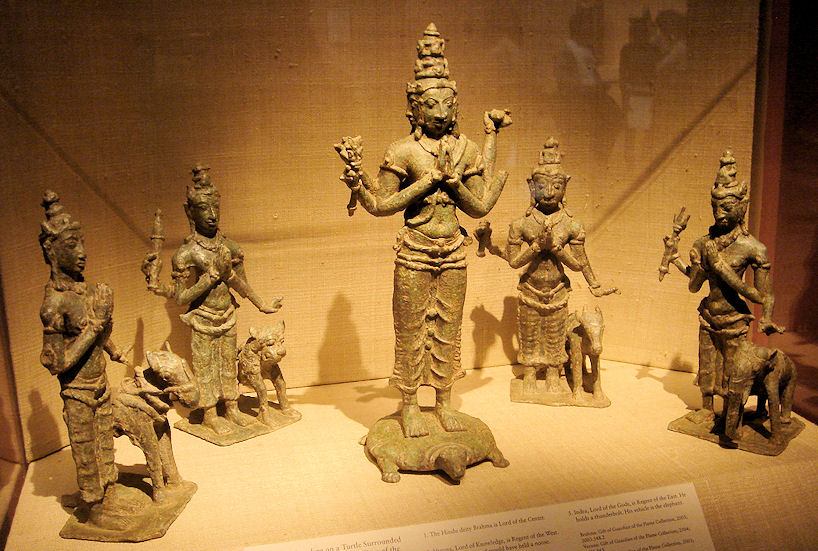
Abb.: Lokapālas: im Zentrum Brahma, von links nach rechts: Varuṇa, Kubera, Yama,
Indra
[Bildquelle: shibainu. --
http://www.flickr.com/photos/50576994@N00/1413044344. -- Zugriff am
2010-07-07. --
Creative Commons Lizenz (Namensnennung)]
"LOKA-PĀLAS. 'Supporters or guardians of the world'. The guardian deities who preside over the eight points of the compass, i.e., the four cardinal and four intermediate points of the compass :
Indra, east ;
Agni, south-east ;
Yama, south;
Sūrya, south-west;
Varuṇa, west;
Vāyu, north-west;
Kuvera, north;
Soma, north-east.
Nirṛti is by some substituted for No. 4, and Pṛthivī or Śiva, especially in his form Īśāna, for No. 8.
Each of these guardian deities has an elephant who takes part in the defence and protection of the quarter, and these eight elephants are themselves called Loka-pālas :
Indra's elephant at the east is Airāvata. He is also called Abhra-mātaṅga, 'elephant of the clouds' ; Arka-sodara, 'brother of the sun' ; Nāga-malla, 'the fighting elephant'; Sadā-dāna, 'always in rut'; Madāmbara, 'covered with ichor'. His wife s name is Abhramu.
Agni's elephant at the south-east is Puṇḍarīka and his female Kapilā.
Yama's at the south is Vāmana and his female Piṅgalā.
Sūrya's at the south-west is Kumuda and his female is Anupamā.
Varuṇa's at the west is Añjana, whose female is Añjanavatī.
Vāyu's at the north-west is Puṣpa-danta, whose female is Śubha-dantī.
Kuvera's at the north is Sarva-bhauma ; and
Soma's elephant at the north-east is Su-pratīka.
The two other females are Añjanā and Tāmra-karṇī, whose spouses are doubtful. Añjanavatī is sometimes assigned to Su-pratīka. In the Rāmāyaṇa
Indra's eastern elephant is called Virūpakṣa ;
Varuṇa's elephant at the west, Saumanasa;
Yama's at the south is Mahā-padma, and
Kuvera's at the north is Hima-pāṇḍara"
[Quelle: Dowson, John <1820-1881>: A classical dictionary of Hindu mythology and religion, geography, history, and literature. -- London, Trübner, 1879. -- s.v. ]
2 Indra, Feuer (Agni), Herr der verstorbenen Vorfahren (Manen) (Yama), Varuṇa, Marut (Vāyu), Kubera
siehe:
Amarasiṃha <6./8. Jhdt. n. Chr.>: Nāmaliṅgānuśāsana (Amarakośa) / übersetzt von Alois Payer <1944 - >. -- 1. Prathamam kāṇḍam. -- 1. svargavargaḥ. -- URL: http://www.payer.de/amarakosa/amara101.htm
3 Nairṛta - नैरृत m.: Nairṛta
"NAIRṚTA. Belonging to the south-west quarter; the regent of that quarter. An imp, goblin, or Rākṣasa." [Quelle: Dowson, John <1820-1881>: A classical dictionary of Hindu mythology and religion, geography, history, and literature. -- London, Trübner, 1879. -- s.v. ]
4 Īśa - ईश m.: Iśa (Īśāna)
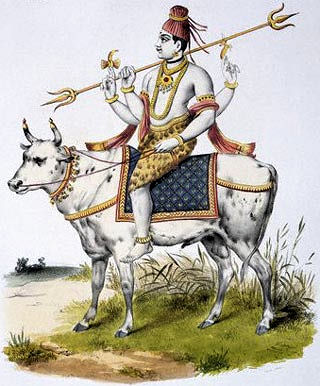
Abb.: Īśāna
[Bildquelle: Wikipedia. -- Public domain]
"ĪŚĀNA. A name of Śiva or Rudra, or of one of his manifestations. (See Rudra.) He is guardian of the north-east quarter." [Quelle: Dowson, John <1820-1881>: A classical dictionary of Hindu mythology and religion, geography, history, and literature. -- London, Trübner, 1879. -- s.v. ]
3. raviḥ śukro mahīsūnuḥ svarbhānur bhānujo vidhuḥ
budho bṛhaspatiś ceti diśāṃ caiva tathā grahāḥ
रविः शुक्रो महीसूनुः स्वर्भानुर् भानुजो विधुः ।
बुधो बृहस्पतिश् चेति दिशां चैव तथा ग्रहाः ॥३॥
Die den jeweiligen Himmelsrichtungen zugehörigen Wandelsterne1 sind:
Erläuterungen:
1 Wandelsterne
| Nordwesten Marut (Vāyu) Mond |
Norden Kubera Merkur |
Nordosten Īśa (Īśāna) Jupiter |
|
Westen Varuṇa Saturn |
|
Osten Indra Sonne |
| Südwesten Nairṛta Rāhu |
Süden Pitṛpati (Yama) Mars |
Südosten Vahni (Agni) Venus |
| [Bildquelle: Abhijitsathe / Wikimedia commons. -- GNU FDLicense] | ||
2 Osten - रवि m.: Sonne
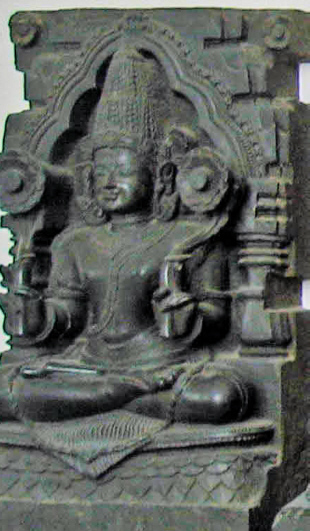
Abb.: Sūrya - Sonne
[Bildquelle: Redtigerxyz / Wikipedia. -- GNU FDLicense]
"SŪRYA. The sun or its deity. He is one of the three chief deities in the Vedas, as the great source of light and warmth, but the references to him are more poetical than precise. Some times he is identical with Savitṛ and Āditya, sometimes he is distinct. "Sometimes he is called son of Dyaus, sometimes of Aditi. In one passage, Uṣas, the dawn, is his wife, in another he is called the child of the dawns ; he moves through the sky in a chariot drawn by seven ruddy horses or mares." Sūrya has several wives, but, according to later legends, his twin sons the Aśvins, who are ever young and handsome and ride in a golden car as precursors of Uṣas, the dawn, were born of a nymph called Aśvinī, from her having concealed herself in the form of a mare. In the Rāmāyaṇa and Purāṇas, Sūrya is said to be the son of Kaśyapa and Aditi, but in the Rāmāyaṇa he is otherwise referred to as a son of Brahmā. His wife was Sañjñā, daughter of Viśva-karma, and by her he had three children, the Manu Vaivasvata, Yama, and the goddess Yamī, or the Yamunā river. His effulgence was so overpowering that his wife gave him Chāyā (shade) for a handmaid, and retired into the forest to devote herself to religion. While thus engaged, and in the form of a mare, the sun saw her and approached her in the form of a horse. Hence sprang the two Aśvins and Revanta. Sūrya brought back his wife Sañjñā to his home, and her father, the sage Viśva-karma, placed the luminary on his lathe and cut away an eighth of his effulgence, trimming him in every part except the feet. The fragments that were cut off fell blazing to the earth, and from them Viśva-karma formed the discus of Viṣṇu, the trident of Śiva, the weapon of Kuvera, the lance of Kārttikeya, and the weapons of the other gods. According to the Mahā-bhārata, Karṇa was his illegitimate son by Kuntī. He is also fabled to be the father of Śani and the monkey chief Sugrīva. The Manu Vaivasvata was father of Ikṣvāku, and from him, the grandson of the sun, the Sūrya-vaṃśa, or Solar race of kings, draws its origin. In the form of a horse Sūrya communicated the White Yajur-veda to Yajñavalkya, and it was he who bestowed on Satrajit the Syamantaka gem. A set of terrific Rākṣasas called Mandehas made an attack upon him and sought to devour him, but were dispersed by his light. According to the Viṣṇu Purāṇa he was seen by Sattrājita in "his proper form," "of dwarfish stature, with a body like burnished copper, and with slightly reddish eyes." Sūrya is represented in a chariot drawn by seven horses, or a horse with seven heads, surrounded with rays. His charioteer is Aruṇa or Vivasvat, and his city Vivaswatī or Bhāswatī. There are temples of the sun, and he receives worship. The names and epithets of the sun are numberless. He is Savitṛ, 'the nourisher' ; Vivasvat, 'the brilliant' ; Bhāskara, 'light-maker' ; Dina-kara, 'day-maker' ; Arha-pati, 'lord of day' ; Loka-cakṣuḥ, 'eye of the world' ; Karma-sākṣī, 'witness of the deeds (of men)' ; Graha-rāja, 'king of the constellations' ; Gabhastimān, 'possessed of rays' ; Sahasra-kiraṇa, 'having a thousand rays' ; Vikarttana, 'shorn of his beams' (by Viśva-karma); Mārtaṇḍa, 'descended from Mṛtaṇḍa' &c. Sūrya s wives are called Savarṇā, Svātī, and Mahā-vīryā."
[Quelle: Dowson, John <1820-1881>: A classical dictionary of Hindu mythology and religion, geography, history, and literature. -- London, Trübner, 1879. -- s.v. ]
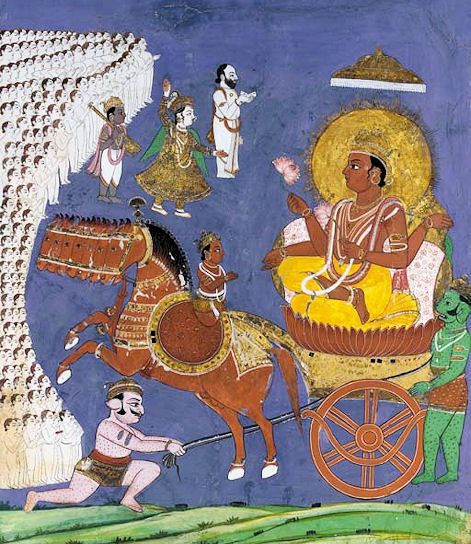
Abb.: Sūrya, Tanjore School, 19. Jhdt. n. Chr.
[Bildquelle: Wikiepdia. -- Public domain]
3 Südosten - शुक्र m.: Venus
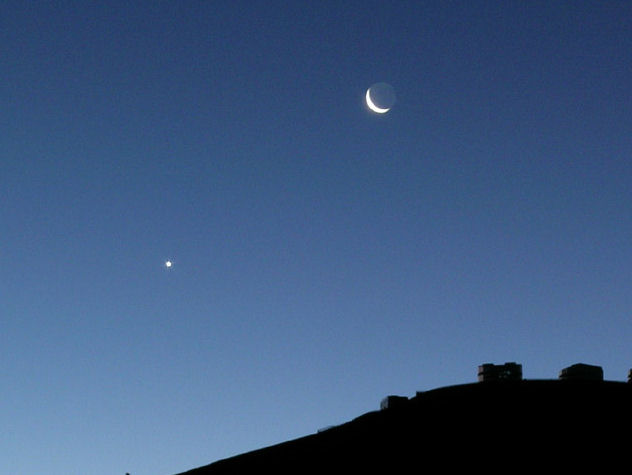
Abb.: Planet Venus
[Bildquelle: Gerhard Hüdepohl / Wikipedia]
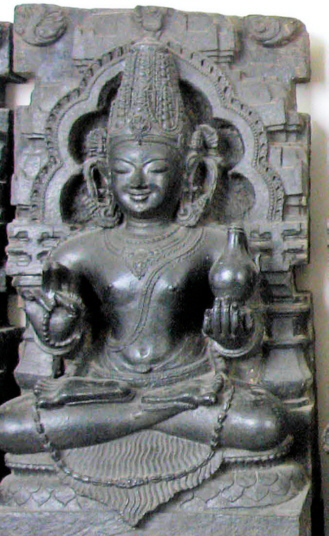
Abb.: Śukra - Venus
[Bildquelle: Redtigerxyz / Wikipedia. -- GNU FDLicense]
"ŚUKRA. The planet Venus and its regent. Śukra was son of Bhṛgu and priest of Bali and the Daityas (Daitya-guru). He is also called the son of Kavi. His wife's name was Śuśumā or Śata-parvā. His daughter Devayānī married Yāyati of the Lunar race, and her husband's infidelity induced Śukra to curse him. Śukra is identified with Uśanas, and is author of a code of law. The Hari-vaṃśa relates that he went to Śiva and asked for means of protecting the Asuras against the gods, and for obtaining his object he performed "a painful rite, imbibing the smoke of chaff with his head downwards for a thousand years." In his absence the gods attacked the Asuras and Viṣṇu killed his mother, for which deed Śukra cursed him "to be born seven times in the world of men." Śukra restored his mother to life, and the gods being alarmed lest Śukra s penance should be accomplished, Indra sent his daughter Jayantī to lure him from it. She waited upon him and soothed him, but he accomplished his penance and afterwards married her. Śukra is known by his patronymic Bhārgava, and also as Bhṛgu. He is also Kavi or Kāvya, 'the poet'. The planet is called Āsphujit, Ἀφροδίτη ; Maghā-bhava, 'son of Maghā'; Ṣodaśāṃśu, 'having sixteen rays' and Śveta, the white."
[Quelle: Dowson, John <1820-1881>: A classical dictionary of Hindu mythology and religion, geography, history, and literature. -- London, Trübner, 1879. -- s.v. ]
4 Süden - महीसूनु m.: Sohn der Erde, Mars
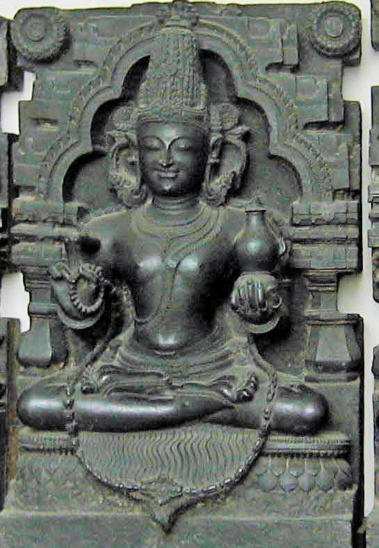
Abb.: Maṅgala - Mars
[Bildquelle: Redtigerxyz / Wikipedia. -- GNU FDLicense]
"MAṄGALA. The planet Mars, identified with Kārtikeya, the god of war. He was son of Śiva and the Earth, and as son of the Earth is called Aṅgāraka, Bhauma, Bhūmī-putra, Mahī-suta. He is also called Śiva-gharma-ja, 'born of the sweat of Śiva' ; Gaganolmuka, 'the torch of the sky' ; 'Lohita', the red ; Navārci, 'the nine-rayed' ; Cara, the spy; Ṛṇāntaka, 'ender of debts', patron of debtors. See Kārtikeya."
[Quelle: Dowson, John <1820-1881>: A classical dictionary of Hindu mythology and religion, geography, history, and literature. -- London, Trübner, 1879. -- s.v. ]
5 Südwesten स्वर्भानु m.: Himmelsglanz, Rāhu
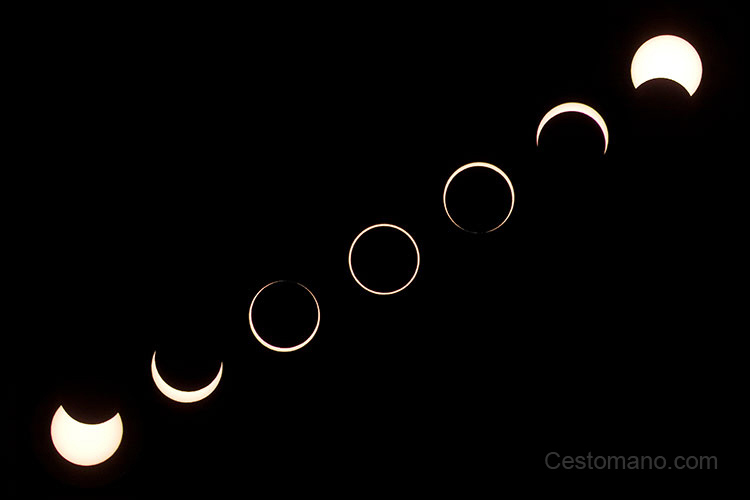
Abb.: Das Werk Rāhus: Sonnenfinsternis
[Bildquelle: Cestomano. --
http://www.flickr.com/photos/cestomano/2298035946/. -- Zugriff am
2010-07-10. --
Creative
Commons Lizenz (Namensnennung, keine kommerzielle Nutzung, share alike)]
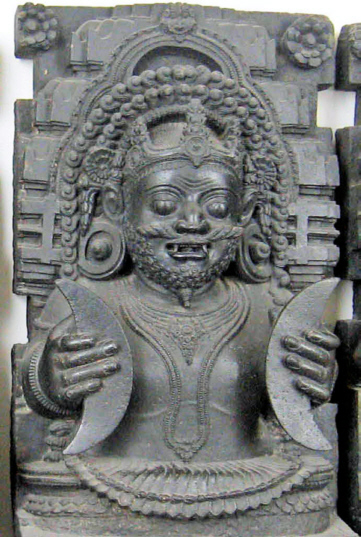
Abb.: Rāhu
[Bildquelle: Redtigerxyz / Wikipedia. -- GNU FDLicense]
Siehe:
Payer, Alois <1944 - >: Dharmashastra : Einführung und Überblick. -- 10. Sakramente und Übergangsriten (samskara). -- Anhang C: Rahu und Ketu, die unsichtbaren Wandelsterne . -- URL: http://www.payer.de/dharmashastra/dharmash10c.htm
"RĀHU. Rāhu and Ketu are in astronomy the ascending and descending nodes. Rāhu is the cause of eclipses, and the term is used to designate the eclipse itself. He is also considered as one of the planets, as king of meteors, and as guardian of the south-west quarter. Mythologically Rāhu is a Daitya who is supposed to seize the sun and moon and swallow them, thus obscuring their rays and causing eclipses. He was son of Vipracitti and Sinhikā, and is called by his metronymic Sainhikeya. He had four arms, and his lower part ended in a tail. He was a great mischief-maker, and when the gods had produced the Amṛta by churning the ocean, he assumed a disguise, and insinuating himself amongst them, drank some of it. The sun and moon detected him and informed Viṣṇu, who cut off his head and two of his arms, but, as he had secured immortality, his body was placed in the stellar sphere, the upper parts, represented by a dragon s head, the ascending node, and the lower parts, represented by a dragon s tail, being Ketu the descending node. Rāhu wreaks his vengeance on the sun and moon by occasionally swallowing them. The Viṣṇu Purāṇa says, "Eight black horses draw the dusky chariot of Rāhu, and once harnessed are attached to it for ever. On the Parvans (nodes, or lunar and solar eclipses) Rāhu directs his course from the sun to the moon, and back again from the moon to the sun. The eight horses of the chariot of Ketu, swift as the wind, are of the dusky red colour of lac, or of the smoke of burning straw." Rāhu is called Abhra-piśāca, 'the demon of the sky' ; Bharaṇī-bhū, 'born from the asterism Bharaṇī'; Graha, 'the seizer' ; Kabandha, 'the headless'."
[Quelle: Dowson, John <1820-1881>: A classical dictionary of Hindu mythology and religion, geography, history, and literature. -- London, Trübner, 1879. -- s.v. ]
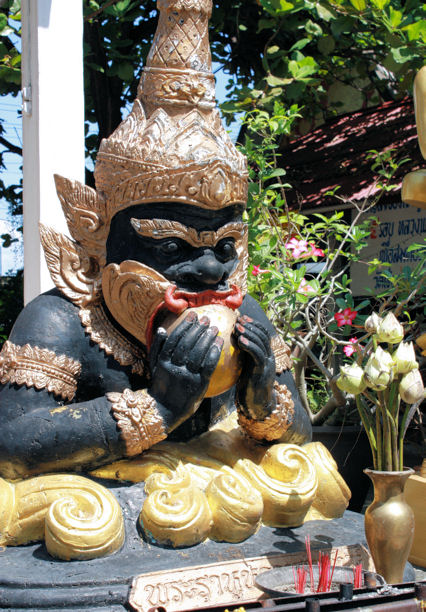
Abb.: Rāhu (พระราหู), Wat Chiangkang Sarapee, Chiang Mai (เชียงใหม่),
Thailand
[Bildquelle: LigerCommon / Wikimedia commons. -- Public domain]
6 Westen - भानुज m.: Sohn der Sonne, Saturn
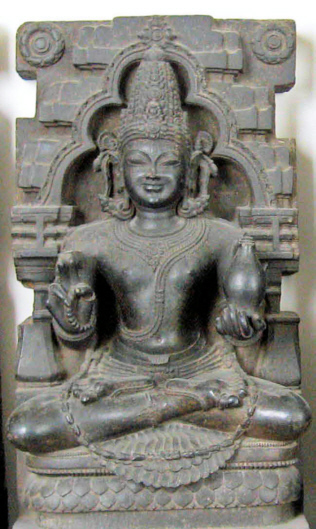
Abb.: Śani - Saturn
[Bildquelle: Redtigerxyz / Wikipedia. -- GNU FDLicense]
"ŚANI. The planet Saturn. The regent of that planet, represented as a black man in black garments. Śani was a son of the sun and Chāyā, but another statement is that he was the offspring of Bala-rāma and Revatī. He is also known as Āra, Koṇa, and Kroda (cf. Koovo;), and by the patronymic Śaura. His influence is evil, hence he is called Krūra-dṛś and Krūra-locana, 'the evil-eyed one'. He is also Manda, 'the slow' ; Paṅgu, 'the lame'; Sanaiś-cara, 'slow-moving'; Saptārcī, 'seven-rayed'; and Asita, 'the dark'."
[Quelle: Dowson, John <1820-1881>: A classical dictionary of Hindu mythology and religion, geography, history, and literature. -- London, Trübner, 1879. -- s.v. ]
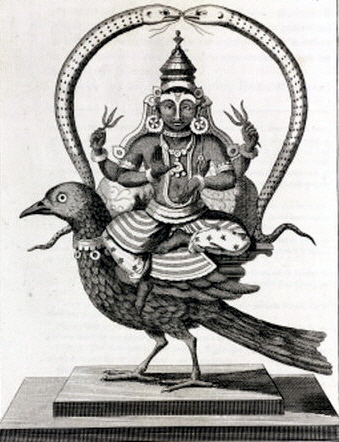
Abb.: Śani, 1782
[Bildquelle: Wikipedia. -- Public domain]
7 Nordwesten - विधु m.: Mond
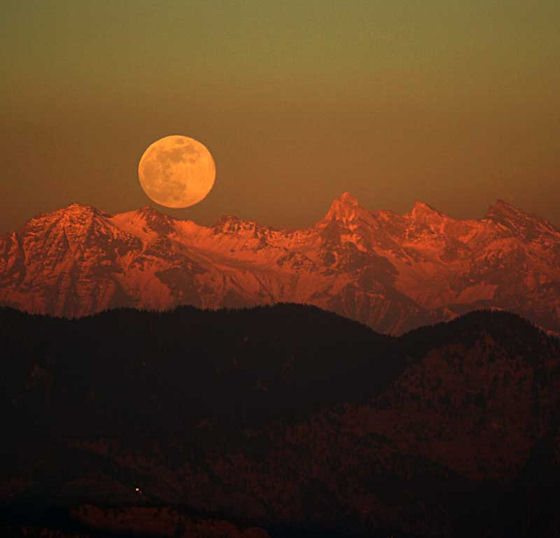
Abb.: Mond über dem Himālaya
[Bildquelle: swamysk. --
http://www.flickr.com/photos/swamysk/364525626/. -- Zugriff am 2010-07-10.
-- Creative
Commons Lizenz (Namensnennung, keine kommerzielle Nutzung, keine
Bearbeitung)]
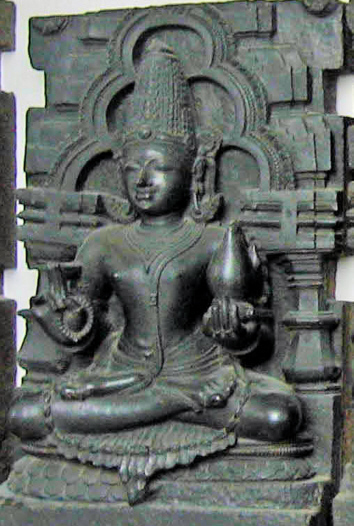
Abb.: Candra - Mond
[Bildquelle: Redtigerxyz / Wikipedia. -- GNU FDLicense]
"SOMA. [...] In later times, the name [Soma] was appropriated to the moon, and some of the qualities of the soma juice have been transferred to the luminary, who is Oṣadhi-pati, or 'lord of herbs'. So Soma is considered the guardian of sacrifices and penance, asterisms and healing herbs.
In the Purāṇic mythology Soma, as the moon, is commonly said to be the son of the Ṛṣi Atri by his wife Anasūyā, but the authorities are not agreed. One makes him son of Dharma ; another gives his paternity to Prabhākara, of the race of Atri; and he is also said to have been produced from the churning of the ocean in another Manvantara. In the Viṣṇu Purāṇa he is called "the monarch of Brāhmaṇs" ; but the Bṛhad Āraṇyaka, an older work, makes him a Kṣatriya. He married twenty-seven daughters of the Ṛṣi Dakṣa, who are really personifications of the twenty-seven lunar asterisms ; but keeping up the personality, he paid such attention to Rohiṇī, the fourth of them, that the rest became jealous, and appealed to their father. Dakṣa's interference was fruitless, and he cursed his son-in-law, so that he remained childless, and became affected with consumption. This moved the pity of his wives, and they interceded with their father for him. He could not recall his curse, but he modified it so that the decay should be periodical, not permanent. Hence the wane and increase of the moon. He performed the Rāja-sūya sacrifice, and became in consequence so arrogant and licentious that he carried off Tārā, the wife of Bṛhaspati, and refused to give her up either on the entreaties of her husband or at the command of Brahmā. This gave rise to a wide-spread quarrel. The sage Uśanas, out of enmity to Bṛhaspati, sided with Soma, and he was supported by the Dānavas, the Daityas, and other foes of the gods. Indra and the gods in general sided with Bṛhaspati. There ensued a fierce contest, and "the earth was shaken to her centre." Soma had his body cut in two by Śiva s trident, and hence he is called Bhagnātmā. At length Brahmā interposed and stopped the fight, compelling Soma to restore Tārā to her husband. The result of this intrigue was the birth of a child, whom Tārā, after great persuasion, declared to be the son of Soma, and to whom the name of Budha was given : from him the Lunar race sprung.
According to the Purāṇas, the chariot of Soma has three wheels, and is drawn by ten horses of the whiteness of the jasmine, five on the right half of the yoke, and five on the left.
The moon has many names and descriptive epithets, as Candra, Indu, Śasī, 'marked like a hare'; Niśākara, 'maker of nigh't; Nakṣatra-nātha, 'lord of the constellations'; Śīta-marīci, 'having cool rays' ; Sitāṃśu, 'having white rays' ; Mṛgāṅka, 'marked like a deer'; Śiva-sekhara, 'the crest of Śiva' ; Kumuda-pati, 'lord of the lotus' ; Śweta-vājī, 'drawn by white horses'."
[Quelle: Dowson, John <1820-1881>: A classical dictionary of Hindu mythology and religion, geography, history, and literature. -- London, Trübner, 1879. -- s.v. ]
8 Norden - बुध m.: Merkur
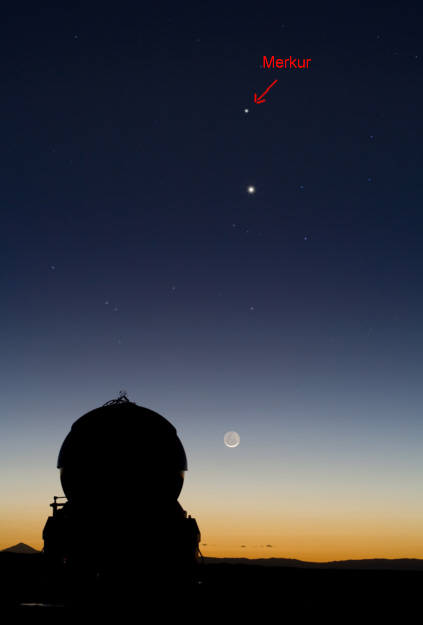
Abb.: Mond, Venus und Merkur
[Bildquelle: European Southern Observatory / Wikimedia commons. --
Creative Commons
Lizenz (Namensnennung)]
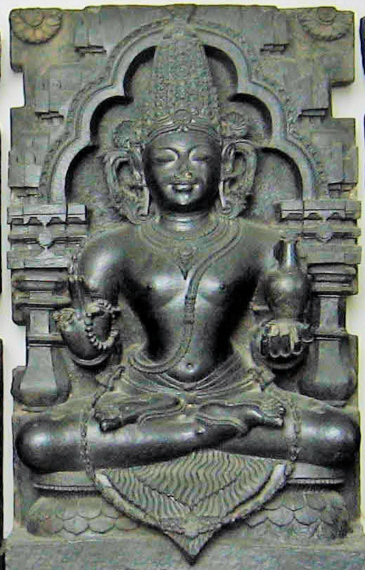
Abb.: Budha - Merkur
[Bildquelle: Redtigerxyz / Wikipedia. -- GNU FDLicense]
"BUDHA. Wise, intelligent. The planet Mercury, son of Soma, the moon, by Rohiṇī, or by Tārā, wife of Bṛhaspati. (See Bṛhaspati) He married Ilā, daughter of the Manu Vaivasvata, and by her had a son, Purūravas. Budha was author of a hymn in the Ṛig-vecla. (See Ilā.) From his parents he is called Saumya and Rauhineya. He is also called Praharṣaṇa, Rodhana, Tuṅga, and Śyāmāṅga, 'black-bodied'. The intrigue of Soma with Tārā was the cause of a great quarrel, in which the gods and the Asuras fought against each other. Brahmā compelled Soma to give up Tārā, and when she returned to her husband she was pregnant. A son was born, who was so beautiful that Bṛhaspati and Soma both claimed him. Tārā for a long time refused to tell his paternity, and so excited the wrath and nearly incurred the curse of her son. At length, upon the command of Brahmā, she declared Soma to be the father, and he gave the boy the name of Budha. This name is distinct from Buddha."
[Quelle: Dowson, John <1820-1881>: A classical dictionary of Hindu mythology and religion, geography, history, and literature. -- London, Trübner, 1879. -- s.v. ]
9 Nordosten - बृहस्पति m.: Jupiter
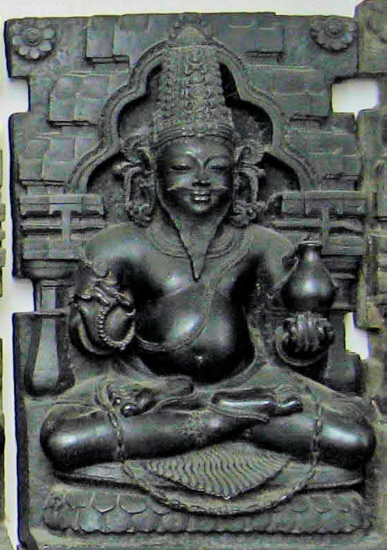
Abb.: Bṛhaspati - Jupiter
[Bildquelle: Redtigerxyz / Wikipedia. -- GNU FDLicense]
"BṚHASPATI. In the Ṛg-veda the names Bṛhaspati and Brahmaṇaspati alternate, and are equivalent to each other. They are names "of a deity in whom the action of the worshipper upon the gods is personified. He is the suppliant, the sacrificer, the priest, who intercedes with gods on behalf of men and protects mankind against the wicked. Hence he appears as the prototype of the priests and priestly order; and is also designated as the Purohita (family priest) of the divine community. He is called in one place the father of the gods, and a widely extended creative power is ascribed to him. He is also designated as 'the shining' and 'the gold-coloured', and as 'having the thunder for his voice'."
In later times he is a Ṛṣi. He is also regent of the planet Jupiter, and the name is commonly used for the planet itself. In this character his car is called Nīti-ghoṣa and is drawn by eight pale horses. He was son of the Ṛṣi Aṅgiras, and he bears the patronymic Āṅgirasa. As preceptor of the gods he is called Animiṣācārya, Cakṣas, Ijya, and Indrejya. His wife, Tārā, was carried off by Soma, the moon, and this gave rise to a war called the Tārakā-maya. Soma was aided by Uśanas, Rudra, and all the Daityas and Dānavas, while Indra and the gods took the part of Bṛhaspati. "Earth, shaken to her centre," appealed to Brahmā, who interposed and restored Tārā to her husband. She was delivered of a son which Bṛhaspati and Soma both claimed, but Tārā, at the command of Brahmā to tell the truth, declared Soma to be the father, and the child was named Budha. There is an extraordinary story in the Matsya and Bhāgavata Purāṇas of the Ṛṣis having milked the earth through Bṛhaspati. (See Viṣṇu Purāṇa, i. pp. 188, 190.) Bṛhaspati was father of Bharadvāja by Mamatā, wife of Utathya. (See Bharadvāja.) An ancient code of law bears the name of Bṛhaspati, and he is also represented as being the Vyāsa of the "fourth, Dvāpara age." There was a Ṛṣi of the name in the second Manvantara, and one who was founder of an heretical sect. Other epithets of Bṛhaspati are Jīva, 'the living', Dīdivis, 'the bright', Dhīṣaṇa, 'the intelligent', and, for his eloquence, Gīṣ-pati, 'lord of speech'."
[Quelle: Dowson, John <1820-1881>: A classical dictionary of Hindu mythology and religion, geography, history, and literature. -- London, Trübner, 1879. -- s.v. ]
4. airāvataḥ puṇḍarīko vāmanaḥ kumudo 'ñjanaḥ
puṣpadantaḥ sārvabhaumaḥ supratīkaś ca diggajāḥ
5. kariṇyo 'bhramu-kapilā piṅgalānupamāḥ kramāt
tāmrakarṇī śubhradantī cāṅganā cāñjanāvatī
ऐरावतः पुण्डरीको वामनः कुमुदो
ऽञ्जनः ।
पुष्पदन्तः सार्वभौमः सुप्रतीकश् च दिग्गजाः ॥४॥
करिण्यो
ऽभ्रमु कपिला पिङ्गलानुपमाः क्रमात् ।
ताम्रकर्णी शुभ्रदान्ती चाङ्गना चाञ्जनावती ॥५॥
Die Elefanten der Himmelsrichtungen1 sind:
Westen - अञ्जन m.: Añjana ("schwarze Salbe")
Die entsprechenden Elefantinnen1 sind:
Erläuterungen:
1 दिग्गज - Elefanten der Himmelsrichtungen und ihre Weibchen
| Nordwesten Marut (Vāyu) Mond Puṣpadanta Śubhradantī |
Norden Kubera Merkur Sārvabhauma Aṅganā |
Nordosten Īśa (Īśāna) Jupiter Supratīka Añjanāvatī |
|
Westen Varuṇa Saturn Añjana Tāmrakarṇī |
|
Osten Indra Sonne Airāvata Abhramu |
| Südwesten Nairṛta Rāhu Kumuda Anupamā |
Süden Pitṛpati (Yama) Mars Vāmana Piṅgalā |
Südosten Vahni (Agni) Venus Puṇḍarīka Kapilā |
| [Bildquelle: Abhijitsathe / Wikimedia commons. -- GNU FDLicense] | ||
2 Airāvata - ऐरावत m.: Airāvata
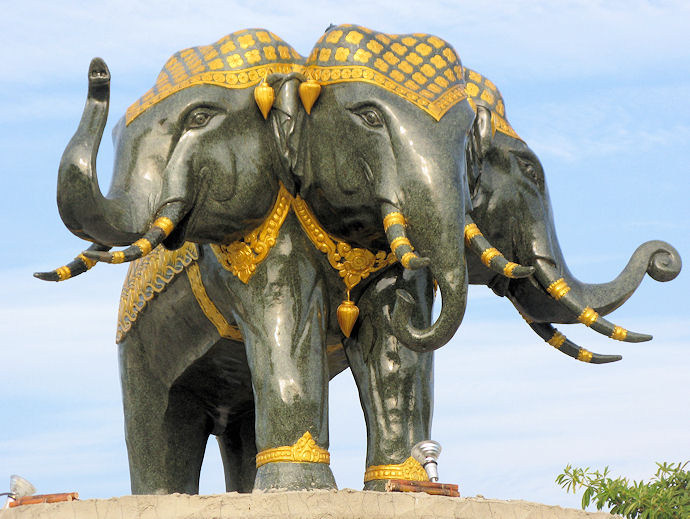
Abb.: Airāvata = Airāvaṇa (เอราวัณ),
Chiang Mai (เชียงใหม่), Thailand
[Bildquelle: Phó Nháy / Wikipedia. -- Public domain]
"AIRĀVATA. 'A fine elephant'. An elephant produced at the churning of the ocean, and appropriated by the god Indra. The derivation of this name is referred to the word Irāvat, signifying produced from water. He is guardian of one of the points of the compass. See Loka-pāla."
[Quelle: Dowson, John <1820-1881>: A classical dictionary of Hindu mythology and religion, geography, history, and literature. -- London, Trübner, 1879. -- s.v. ]
6. klībāvyayaṃ tv apadiśaṃ diśor madhye vidik striyām
abhyantaraṃ tv antarālaṃ cakravālaṃ tu maṇḍalam
क्लिबाव्ययं त्व् अपदिशं दिशोर् मध्ये विधिक्
स्त्रियाम् ।
अभ्यन्तरं त्व् अन्तरालं चक्रवालं तु मण्डलम् ॥६॥
Für die Mitte zwischen zwei Himmelsrichtungen gebraucht man:
Der Zwischenraum (अभ्यन्तर n.) heißt अन्तराल n.: Zwischenraum, Zwischenzeit
Der (Gesichts)kreis (मण्डल n.: Kreis, Scheibe) चक्रवाल n.: Kreis, Gruppe
7. abhraṃ megho vārivāhaḥ stanayitnur
valāhakaḥ
dhārādharo jaladharas taḍitvān vārido 'mbubhṛt
8. ghana-jīmūta-mudira-jalamug-dhūmayonayaḥ
kādambinī meghamālā triṣu meghabhave 'bhriyam
अभ्रं मेघो वारिवाहः स्तनयित्नुर् वलाहकः ।
धराधरो जलधरस् तडित्वान् वारिदो
ऽम्बुभृत् ॥७॥
घन-जीमूत-मुदिर-जलमुग्-धूमयोनयः ।
कादम्बिनी मेघमाला त्रिषु मेघभवे
ऽभ्रियम् ॥८॥
[Bezeichnungen für Wolke sind:]
Eine Reihe von Wolken heißt
Für den Wolkenzustand verwendet man
Erläuterungen:
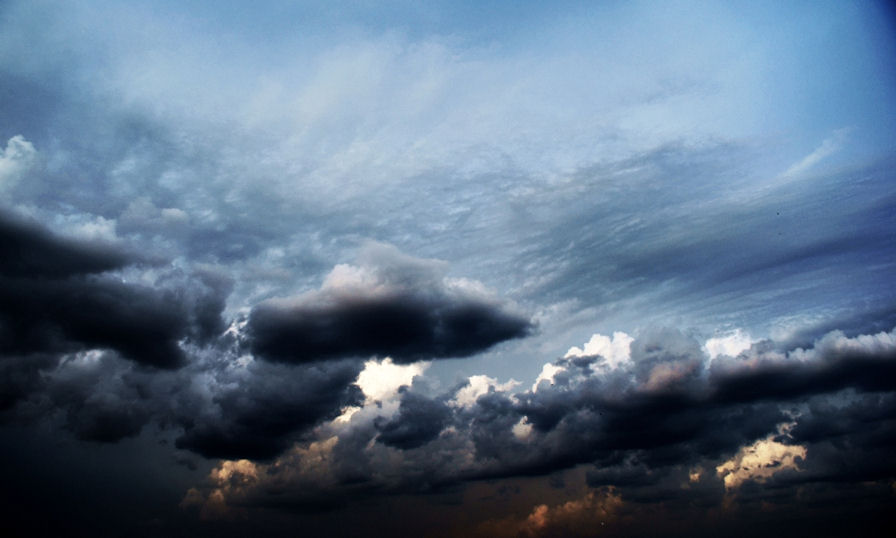
Abb.: Monsunwolken, Hyderabad (హైదరాబాద్,
حیدرآباد),
Andhra Pradesh
[Bildquelle: { pranav }. --
http://www.flickr.com/photos/neychurluvr/3725141627/. -- Zugriff am
2010-07-10. --
Creative Commons Lizenz (Namensnennung)]
1 Kādambinī - कादम्बिनी f.: Wolkenbank (wie [ein Zug von] Streifengänsen - kādamba - Anser indicus Latham)
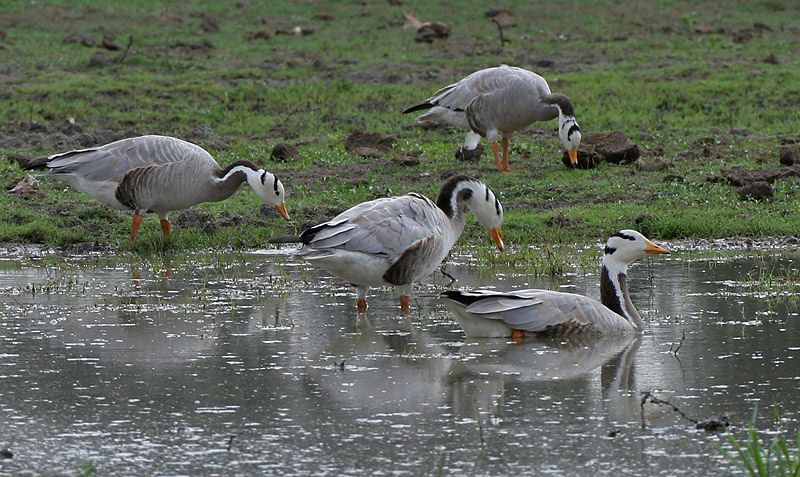
Abb.: kādamba - Anser indicus Latham - Streifengänse, Keoladeo
National Park (केवलादेव राष्ट्रीय उद्यान), Rajasthan
[Bildquelle: J. M. Garg / Wikipedia. -- GNU FDLicense]
9. stanitaṃ garjitam meghanirghoṣe rasitādi ca
śampā śatahradā-hrādiny-airāvatyaḥ kṣaṇaprabhā
10. taḍit saudāminī vidyuc cañcalā capalā api
sphūrjathur vajranirghoṣo meghajyotir iraṃmadaḥ
स्तनितं गर्जितम् मेघनिर्घोषे रसितादि च ।
शम्पा शतहृदा-ह्रादिन्य्-ऐरावत्यः क्षणप्रभा ॥९॥
तडित् सौदामिनी विद्युच्-चञ्चला-चपला अपि ।
स्फूर्जथुर् वज्रनिर्घोषो मेघज्योतिर् इरम्मदः ॥१०॥
Die Bedeutung "Donner" (meghanirghoṣa - मेघनिर्घोष m. "Wolkenkrachen") haben:
[Bezeichnungen für Blitz sind:]
[Bezeichnungen für Donnerschlag sind:]
[Bezeichnungen für Wetterleuchten sind:]
Erläuterungen:

Abb.: Blitz (animiertes .gif)
[Bildquelle: original data: Sebastien D'ARCO, animate: Koba-chan / Wikipedia. --
Creative Commons
Lizenz (Namensnnennung, share alike)]
1 u. ä.
Jātarūpa: das "u.ä." beinhaltet Wörter wie
- ह्राद m.: Getöne
- रास m.: Geschrei
- ध्वनित n.: Getöne
- u. ä.
(आदिशब्देन ह्राद-रास-ध्वनितादि)
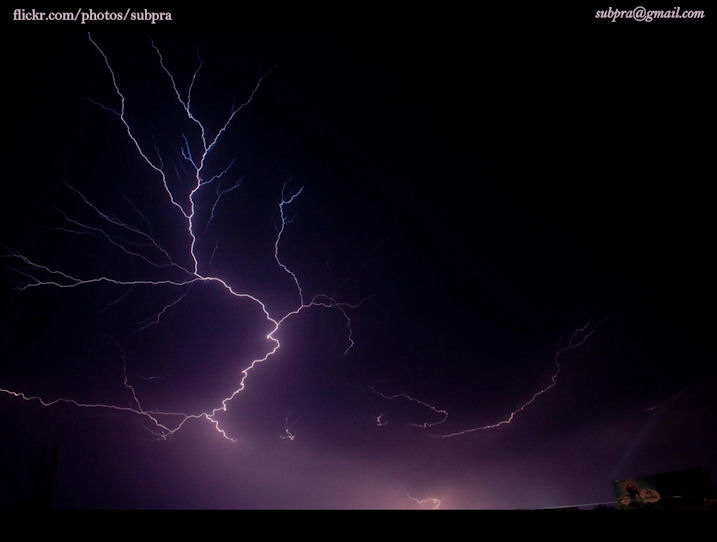
Abb.: Blitze, Karnataka
[Bildquelle: subpra. --
http://www.flickr.com/photos/subpra/4533676164/. -- Zugriff am 2010-07-11.
-- Creative Commons
Lizenz (Namensnennung)]
2 Airāvatī - ऐरावती f.: Airāvatī (zu Airāvata gehörend, von Airāvata stammend)
siehe oben!
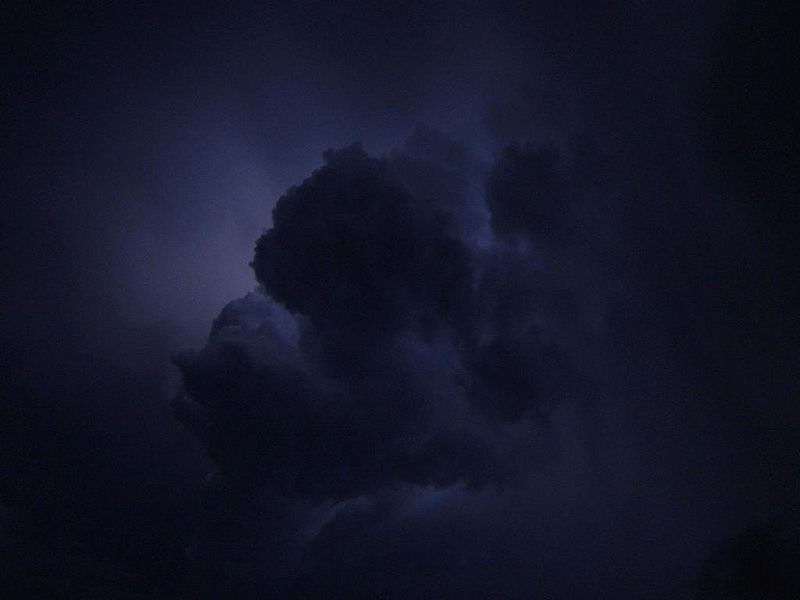
Abb.: Wetterleuchten
[Bildquelle: Christian Arntzen / Wikipedia. -- GNU FDLicense]
11. indrāyudhaṃ śakradhanus tadeva ṛju rohitam
vṛṣṭir varṣaṃ tadvighāte 'vagrāhāvagrahau samau
12. dhārāsampāta āsāraḥ śīkaro 'mbukaṇāḥ smṛtāḥ
varṣopalas tu karakā meghacchanne 'hni durdinam
13. antardhā vyavadhā puṃsi tv antardhir apavāraṇam
apidhāna-tirodhāna-pidhānācchādanāni ca
इन्द्रायुधं शक्रधनुस् तदेव ऋजु रोहितम् ।
वृष्टिर् वर्षं तद्विघाते
ऽवग्राहावग्रहौ समौ ॥११॥
धारासम्पात आसारः
शीकरो ऽम्बुकणाः स्मृताः ।
वर्षोपलस् तु करका मघच्छन्ने ऽह्नि दुर्दिनम्
॥१२॥
अन्तर्धा व्यवधा पुंसि त्व् अन्तर्धिर् अपवारणम् ।
अपिधान-तिरोधान-पिधानाच्छादनानि च ॥१३॥
[Bezeichnungen für Regenbogen sind:]
Wenn dieser Bogen Indras gerade (= nicht gebogen) ist, heißt er Rohita - रोहित n. - "Roter".2
[Bezeichnungen für Regen sind:]
Für das Gegenteil von Regen (= Dürre) sagt man gleichwertig
[Bezeichnungen für schwere Regenschauer (Platzregen) sind:]
Wassertropfen (Nieselregen) bezeichnet man als शीकर m. - Nieselregen, Tröpfeln.
[Hagel nennt man:]
वर्षोपल m.: Regenstein, Hagelstein, Hagel
करका f.: Hagel ("Ausgestreutes")
Einen wolkenbedeckten Tag nennt man दुर्दिन m. - Schlechtwettertag.
[Bedeckung / Verdeckung bezeichnet man als:]
अन्तर्धा f.: Dazwischengestelltes, Bedeckung
व्यवधा f.: Dazwischengestelltes, Trennwand, Verdeckung
अन्तर्धि m.: Dazwischengestelltes, Bedeckung
अपवारण n.: Versteckendes, Bedeckung
अपिधान n.: Bedeckung
तिरोधान n.: Verbergen
पिधान n.: Zudecken
आच्छादन n.: Bedeckung
Erläuterungen:
1 Śakra-dhanus - शक्रधनुस् n.: Bogen Śakras (Indras)
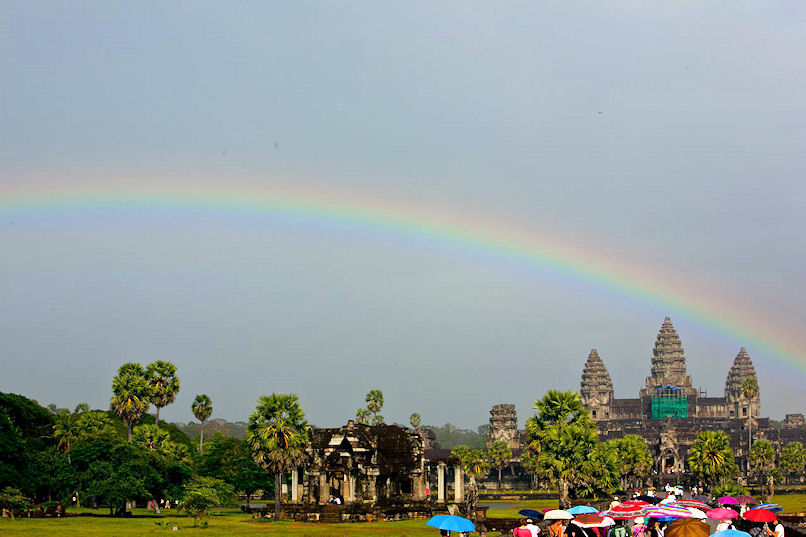
Abb.: "Indras Bogen" über Angkor Wat, Kambodscha
[Bildquelle: littlemalt. --
http://www.flickr.com/photos/littlemalt/4037158320/. -- Zugriff am
2010-07-11. --
Creative
Commons Lizenz (Namensnennung, keine kommerzielle Nutzung, keine
Bearbeitung)]
2 तदेव ऋजु रोहितम्
"When his [Indra's] bow ist bent, its shadow appears as a rainbow ; when unbent, it is unvisible to mortals." (H. T. Colebrooke z. St.)
3 Avagrāha - अवग्राह m.: Dürre ("Wegnahme")
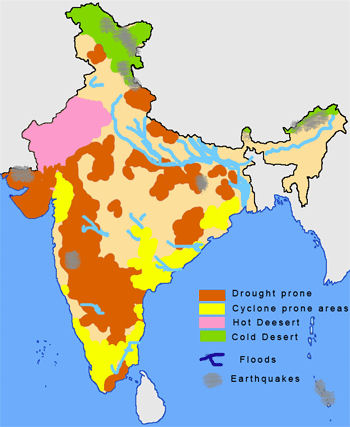
Abb.: Von Dürre bedrohte Gebiete des heutigen Indien
[Bildquelle: Nichalp / Wikimedia commons. -- GNU FDLicense]
14. himāṃśuś candramāś candra induḥ kumudabāndhavaḥ
vidhuḥ sudhāṃśuḥ śubhrāṃśur oṣadhīśo niśāpatiḥ
15. abjo jaivātṛkaḥ somo glaur mṛgāṅkaḥ kalānidhiḥ
dvijarājaḥ śaśadharo nakṣatreśaḥ kṣapākaraḥ
हिमांशुष् चन्द्रमाश् चन्द्र इन्दुः कुमुदबान्धवः
।
विधुः सुधांशुः शुभ्रांशुर् ओषधीशो निशापतिः ॥१४॥
अब्जो जैवातृकः सोमो ग्लौर् मृगाङ्कः कलानिधिः ।
द्विजराजः शशधरो नक्षत्रेशः क्षपाकरः ॥१५॥
[Bezeichnungen für Mond sind:]
Erläuterungen:
1 Mond
zum Mond in der Mythologie siehe oben!
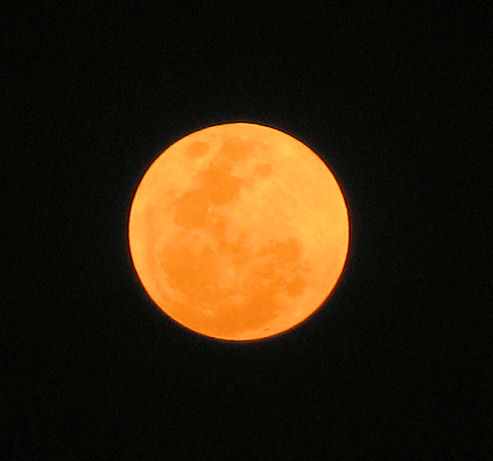
Abb.: Vollmond über Bangalore
[Bildquelle: netlancer2006. --
http://www.flickr.com/photos/netlancer2006/443674325/. -- Zugriff am
2010-07-11. --
Creative Commons Lizenz (Namensnennung)]
2 Kumuda-bāndhava - कुमुदबान्धव m.: Verwandter der weißen Seerose (Nymphaea alba L.)

Abb.: kumuda - Nymphaea alba L. - Weiße Seerose
[Bildquelle: unforth. --
http://www.flickr.com/photos/unforth/2572705105/. -- Zugriff am 2010-07-11.
-- Creative
Commons Lizenz (Namensnennung, share alike)]
3 Kalā-nidhi - कलानिधि m.: Behälter der Sechzentel(-monde)
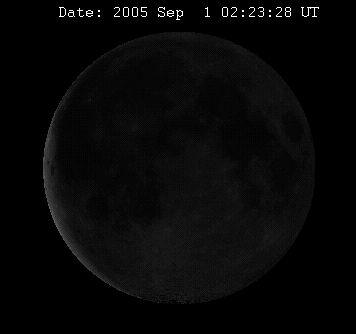
Abb.: Mondphasen (in Indien in Sechzehntel geteilt)
[Bildquelle: Tomruen / Wikipedia. -- Public domain]
4 Śaśa-dhara - शशधर m.: Hasenträger
Während man bei uns z.B. einen Mann im Mond sieht, sieht man in Indien einen Hasen im Mond
5 Nakṣatreśa - नक्षत्रेश m.: Herr der Mondhäuser (Nakṣatra)
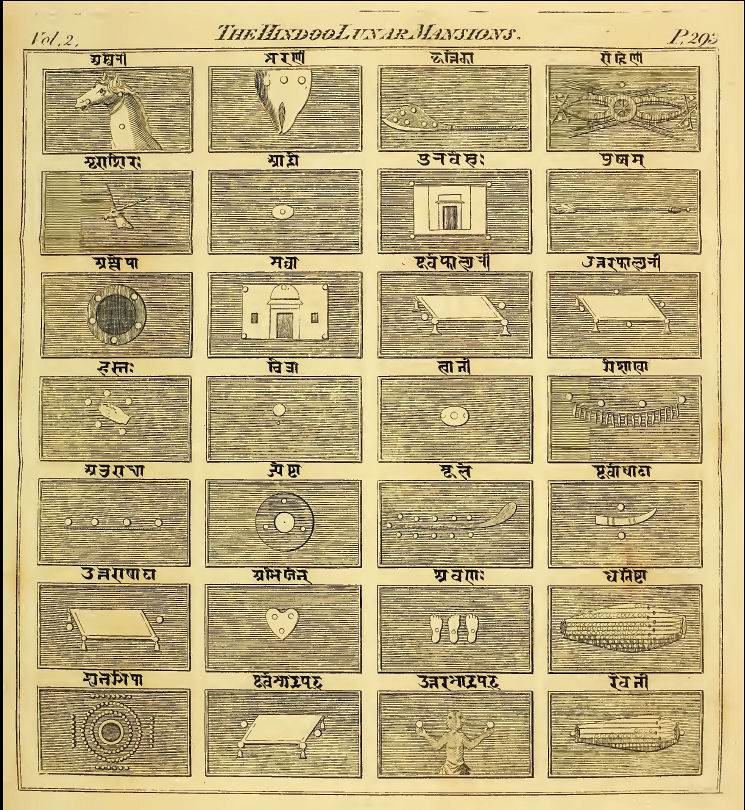
Abb.: Nakṣatra
[Bildquelle: Asiatick Researches II (1799). -- Vor S. 293]
Siehe:
Payer, Alois <1944 - >: Dharmashastra : Einführung und Überblick. -- 10. Sakramente und Übergangsriten (samskara). -- Anhang A: Mondhäuser (Nakṣatra). -- URL: http://www.payer.de/dharmashastra/dharmash10a.htm
16. kalā tu ṣoḍaśo bhāgo bimbo 'strī maṇḍalaṃ triṣu
bhittaṃ śakala-khaṇḍe vā puṃsy ardho 'rdhaṃ same
'ṃśake
17. candrikā kaumudī jyotsnā prasādas tu prasannatā
kalaṅkāṅkau lāñchanaṃ ca cihnaṃ lakṣma ca lakṣaṇam
18 a./b. suṣamā paramā śobhā śobhā kāntir dyutiś cchaviḥ
कला तु षोषशो भागो बिम्बो
ऽस्त्री मण्डलं त्रिषु ।
भित्तं शकल-खण्डे वा पुंस्य् अर्धो ऽर्धं समे ऽंशके ॥१६॥
चन्द्रिका कौमुदी ज्योत्स्ना प्रसादस् तु प्रसन्नता ।
कलङ्काङ्कौ लाञ्छनं च चिह्नं लक्ष्म च लक्षणम् ॥१७॥
सुषमा परमा शोभा शोभा कान्तिर् द्युतिश् च्छविः ।१८ क।
Der sechzehnte Teil heißt kalā - कला f. - ein Sechzehntel, der sechzehnte Teil.
[Bezeichnungen für die Scheibe der Sonne oder des Mondes sind:]
[Bezeichnungen für einen Teil sind:]
Für einen gleichen Teil (Hälfte) sagt man ardha - अर्ध n.: Hälfte.
[Bezeichnungen für Mondschein sind:]
[Bezeichnungen für Klarheit sind:]
[Bezeichnungen für Merkmal sind:]
Höchste Schönheit (paramā śobhā) heißt suṣamā - सुषमा f.: Pracht, Schönheit.
[Bezeichnungen für Schönheit sind:]
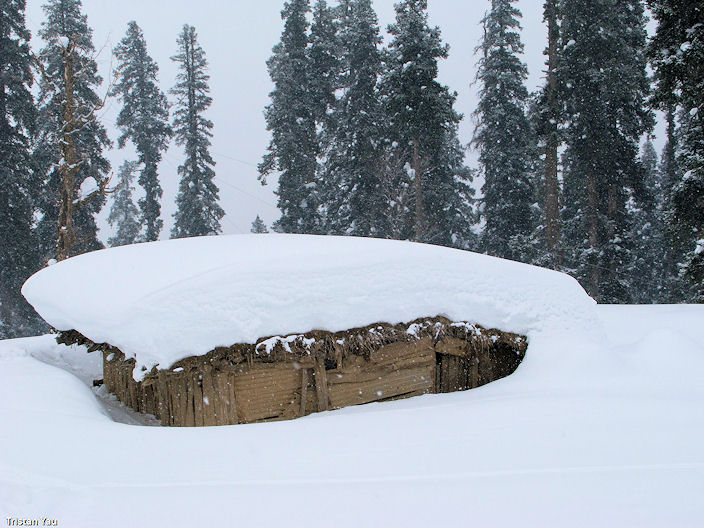
Abb.: Winter in Gulmarg (गुलमर्ग), Kashmir, 2700 m ü. M.
[Bildquelle: trisb. --
http://www.flickr.com/photos/trisb/2282020358/. -- Zugriff am 2010-07-12. --
Creative
Commons Lizenz (Namensnennung, keine kommerzielle Nutzung, keine
Bearbeitung)]
18 c./d. avaśyāyas tu nīhāras tuṣāras tuhinaṃ himam
19. prāleyaṃ mihikā cātha himānī himasaṃhatiḥ
śītaṃ guṇe tadvadarthāḥ suṣīmaḥ śiśiro jaḍaḥ
20 a./b. tuṣāraḥ śītalaḥ śīto himaḥ saptānyaliṅgakāḥ
अवश्यायस् तु नीहारस् तुषारस् तुहिनं हिमम् ॥१८ ख॥
प्रालेयं मिहिका चाथ हिमानी हिमसंहतिः ।
शीतं गुणे तद्बदर्थाः सुषीमः शिशिरो जडः ॥१९॥
तुषारः शीतलः शीतो हिमः सप्तान्यलिङ्गकाः ।२० क।
[Bezeichnungen für Frost sind:]
[Bezeichnungen für tiefen Schnee sind:]
Für die Eigenschaft steht śīta - शीत n.: Kälte, Frost.
Eigenschaftswörter für kalt sind:
20. c./d. dhruva auttānapādiḥ syād agastyaḥ kumbhasambhavaḥ
21. a./b. maitrāvaruṇir asyaiva lopāmudrā sadharmiṇī
ध्रुव औत्तनपादिः स्याद् अगस्त्यः कुम्भसम्भवः ॥२०
ख॥
मैत्रावरुणिर् अस्यैव लोपमुद्रा सधर्मिणी ।२१ क।
[Bezeichnungen für den Polarstern1 sind:]
[Bezeichnungen für den Stern Canopus3 sind:]
Seine tugendhafte Gattin ist Lopamudrā - लोपमुद्रा f.: Lopamudrā5
Erläuterungen:
1 Polarstern
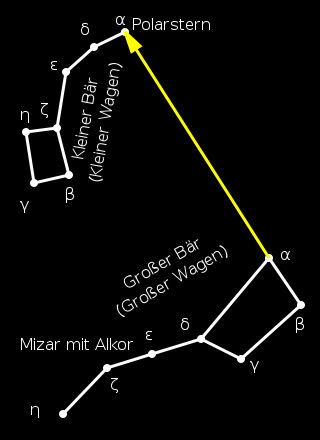
Abb.: Hilfe zum Auffinden des Polarsterns
[Bildquelle: Wikipedia. -- Public domain]
Wenn Sie auf die Schaltfläche klicken,
sehen Sie ein Video zur scheinbaren Rotation der Sterne um den Polarstern
[Quelle der .ogg-Datei: Eclipse.sx / Wikipedia. -- GNU FDLicense]
"Der Polarstern ist der hellste Stern (α) im Sternbild Kleiner Bär (volkstümlich im deutschsprachigen Raum auch Kleiner Wagen genannt). Er befindet sich nahe dem Nordpol des Himmels (Himmelsnordpol) und ist deshalb ein wichtiges Mittel zur Feststellung der geografischen Nordrichtung." [Quelle: http://de.wikipedia.org/wiki/Polarstern. -- Zugriff am 2010-07-12]
2 Dhruva - ध्रुव m.: der Feststehende, Dhruva, Polarstern
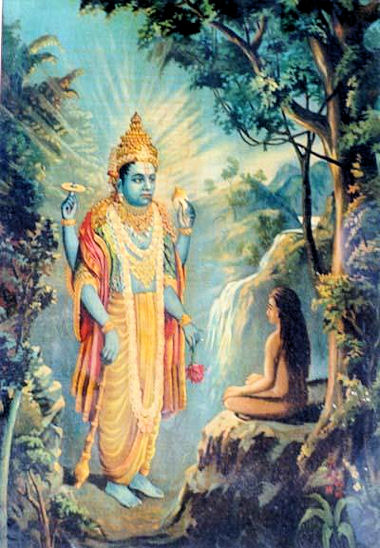
Abb.: Raja Ravi Varma (രാജാ രവി വര്മ)
<1848 - 1906>: Viṣṇu erscheint dem Dhruva
[Bildquelle: Wikipedia. -- Public domain]
"DHRUVA. The polar star. According to the Viṣṇu Purāṇa, the sons of Manu Svāyam-bhuva were Priya-vrata and Uttānapāda. The latter had two wives ; the favourite, Suruci, was proud and haughty; the second, Sunīti or Sūnṛta, was humble and gentle. Suruci had a son named Uttama, and Sunīti gave birth to Dhruva, While quite a child Dhruva was contemptuously treated by Suruci, and she told him that her own son Uttama would alone succeed to the throne. Dhruva and his mother submitted, and he declared that he wished for no other honours than such as his own actions should acquire. He was a Kṣatriya, but he joined a society of Ṛṣis, and becoming a Ṛṣi himself, he went through a rigid course of austerities, notwithstanding the efforts of Indra to distract him. At the end he obtained the favour of Viṣṇu who raised him to the skies as the pole-star. He has the patronymic Auttānapādi, and he is called Grahādhāra, the stay or pivot of the planets."
[Quelle: Dowson, John <1820-1881>: A classical dictionary of Hindu mythology and religion, geography, history, and literature. -- London, Trübner, 1879. -- s.v. ]
3 Canopus
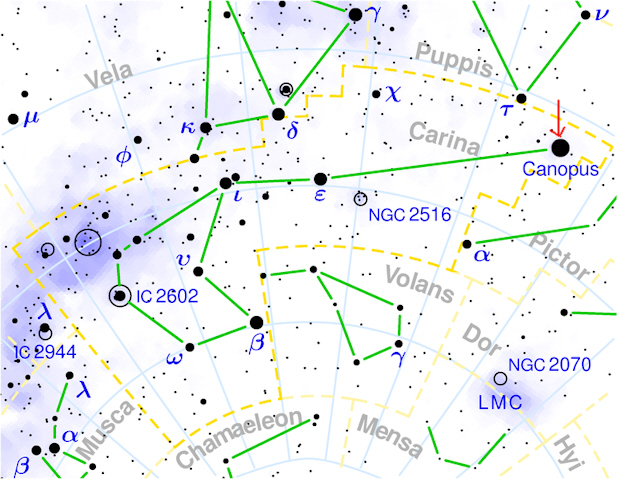
Abb.: Lage von Canopus
[Bildquelle: Torsten Bronger / Wikipedia. -- GNU FDLicense]
"Canopus (α Carinae) ist der hellste Stern im Sternbild 'Kiel des Schiffs' (Carina). Er ist nach Sirius der zweithellste Stern am Nachthimmel, steht aber so weit südlich, dass er von Mitteleuropa aus nicht zu sehen ist. Lediglich vom südlichsten Teil Europas (Gibraltar, Malta, Kreta) aus kann er beobachtet werden. Aufgrund seiner Stellung nahe dem Südpol der Ekliptik dient er vielen Raumflugkörpern wegen seiner großen Helligkeit auch als Leitstern." [Quelle: http://de.wikipedia.org/wiki/Canopus. -- Zugriff am 2010-07-12]
4 Agastya - अगस्त्य m.: Agastya
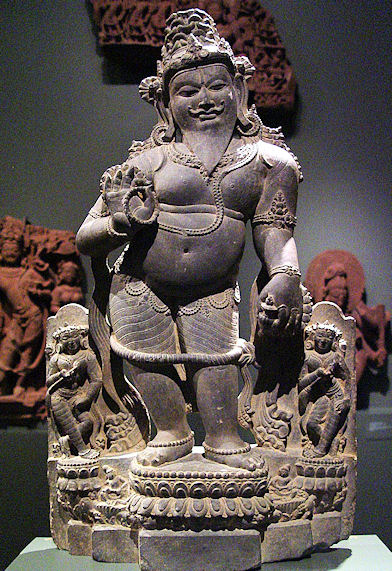
Abb.: Agastya, Bihar, 12. Jhdt. n. Chr.
[Bildquelle: howcheng. --
http://www.flickr.com/photos/93183689@N00/3301029585. -- Zugriff am
2010-07-12. --
Creative Commons Lizenz (Namensnennung, share alike)]
"AGASTI, AGASTYA. A Ṛṣi, the reputed author of several hymns in the Ṛg-veda, and a very celebrated personage in Hindu story. He and Yasiṣṭha are said in the Ṛg-veda to be the offspring of Mitra and Varuṇa, whose seed fell from them at the sight of Urvaśī; and the commentator Sāyana adds that Agastya was born in a water-jar as "a fish of great lustre," whence he was called Kalaśi-suta, Kumbha-sambhava, and Ghaṭodbhava. From his parentage he was called Maitrā-varuṇi and Aurvaśīya ; and as he was very small when he was born, not more than a span in length, he was called Māna. Though he is thus associated in his birth with Vasiṣṭha, he is evidently later in date, and he is not one of the Prajāpatis. His name, Agastya, is derived by a forced etymology from a fable which represents him as having commanded the Vindhya mountains to prostrate themselves before him, through which they lost their primeval altitude; or rather, perhaps, the fable has been invented to account for his name. This miracle has obtained for him the epithet Vindhya-kūṭa; and he acquired another name, Pītābdhi, or Samudra-culuka, 'Ocean drinker', from another fable, according to which he drank up the ocean because it had offended him, and because he wished to help the gods in their wars with the Daityas when the latter had hidden themselves in the waters. He was afterwards made regent of the star Canopus, which bears his name. The Purāṇas represent him as being the son of Pulastya, the sage from whom the Rākṣasas sprang. He was one of the narrators of the Brahma Purāṇa and also a writer on medicine.
The Mahā-bhārata relates a legend respecting the creation of his wife. It says that Agastya saw his ancestors suspended by their heels in a pit, and was told by them that they could be rescued only by his begetting a son. Thereupon he formed a girl out of the most graceful parts of different animals and passed her secretly into the palace of the king of Vidarbha. There the child grew up as a daughter of the king, and was demanded in marriage by Agastya. Much against his will the king was constrained to consent, and she became the wife of the sage. She was named Lopā-mudrā, because the animals had been subjected to loss (lopa) by her engrossing their distinctive beauties, as the eyes of the deer, &c. She was also called Kauśītakī and Vara-pradā. The same poem also tells a story exhibiting his superhuman power, by which he turned King Nahuṣa into a serpent and afterwards restored him to his proper form. See Nahuṣa.
It is in the Rāmāyaṇa that Agastya makes the most distinguished figure. He dwelt in a hermitage on Mount Kuñjara, situated in a most beautiful country to the south of the Vindhya mountains, and was chief of the hermits of the south. He kept the Rākṣasas who infested the south under control, so that the country was "only gazed upon and not possessed by them." His power over them is illustrated by a legend which represents him as eating up a Rākṣasa named Vātāpi who assumed the form of a ram, and as destroying by a flash of his eye the Rākṣasa's brother, Ilvala, who attempted to avenge him. (See Vātāpi.) Rāma in his exile wandered to the hermitage of Agastya with Sītā and Lakṣmaṇa. The sage received him with the greatest kindness, and became his friend, adviser, and protector. He gave him the bow of Viṣṇu ; and when Rāma was restored to his kingdom, the sage accompanied him to Ayodhyā.
The name of Agastya holds a great place also in Tamil literature, and he is "venerated in the south as the first teacher of science and literature to the primitive Dravidian tribes;" so says Dr. Caldwell, who thinks "we shall not greatly err in placing the era of Agastya in the seventh, or at least in the sixth century B.C." Wilson also had previously testified to the same effect: "The traditions of the south of India ascribe to Agastya a principal share in the formation of the Tamil language and literature, and the general tenor of the legends relating to him denotes his having been instrumental in the introduction of the Hindu religion and literature into the Peninsula."
[Quelle: Dowson, John <1820-1881>: A classical dictionary of Hindu mythology and religion, geography, history, and literature. -- London, Trübner, 1879. -- s.v. ]
5 Lopamudrā - लोपमुद्रा f.: Lopamudrā
"LOPĀMUDRĀ. A girl whom the sage Agastya formed from the most graceful parts of different animals and secretly introduced into the palace of the king of Vidarbha, where the child was believed to be the daughter of the king. Agastya had made this girl with the object of having a wife after his own heart, and when she was marriageable he demanded her hand. The king was loath to consent, but was obliged to yield, and she became the wife of Agastya. Her name is explained as signifying that the animals suffered loss (lopa) by her engrossing their distinctive beauties (mudrā), as the eyes of the deer, &c. She is also called Kauśītakī and Vara-pradā. A hymn in the Ṛg-veda is attributed to her."
[Quelle: Dowson, John <1820-1881>: A classical dictionary of Hindu mythology and religion, geography, history, and literature. -- London, Trübner, 1879. -- s.v. ]
21. c./d. nakṣatram ṛkṣaṃ bhaṃ tārā tārakāpy uḍu vā striyām
नक्षत्रं ऋक्षं भं तारा तारकाप्य् उडु वा स्त्रियाम् ॥२१ ख॥
[Bezeichnungen für Stern sind:]
Erläuterungen:
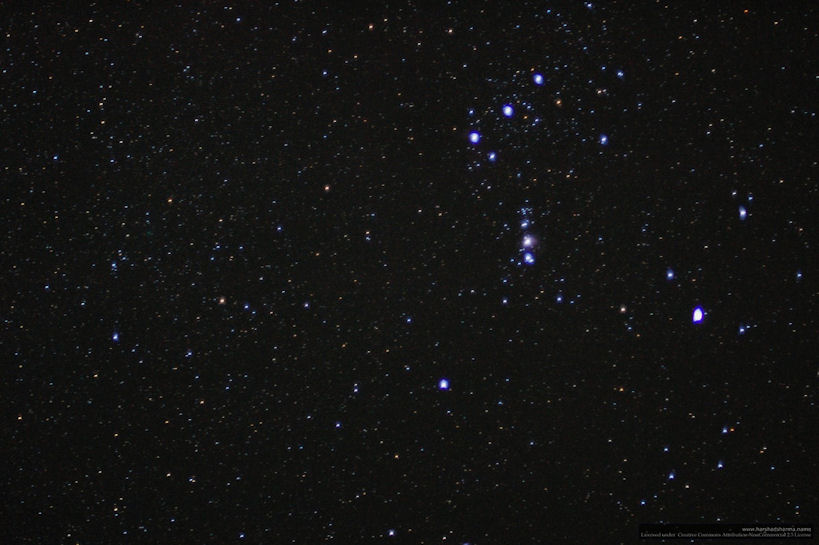
Abb.: Nachthimmel über Ahmednagar (अहमदनगर),
Maharashtra
[Bildquelle: Harshad Sharma. --
http://www.flickr.com/photos/harshadsharma/301019385/. -- Zugriff am
2010-07-12. --
Creative Commons Lizenz (Namensnennung, keine kommerzielle Nutzung)]
1 Nakṣatra - नक्षत्र n.: Stern, Gestirn, Mondhaus (Nakṣatra)
Zu Mondhaus siehe:
Payer, Alois <1944 - >: Dharmashastra : Einführung und Überblick. -- 10. Sakramente und Übergangsriten (samskara). -- Anhang A: Mondhäuser (Nakṣatra). -- URL: http://www.payer.de/dharmashastra/dharmash10a.htm
22. dākṣāyiṇyo 'śvinītyādi-tārā aśvayug aśvinī
rādhā viśākhā puṣye tu sidhya-tiṣyau śraviṣṭhayā
23. samā dhaniṣṭhāḥ syuḥ proṣṭhapadā bhādrapadāḥ striyaḥ
mṛgaśīrṣaṃ mṛgaśiras tasminn evāgrahāyaṇī
24. a./b. ilvalās tacchirodeśe tārakā nivasanti yāḥ
दाक्षायिण्यो
ऽश्विनीत्यादितारा अश्वयुग् अश्विनी ।
राधा विशाखा पुष्ये तु सिध्य-तिष्यौ श्रविष्ठया ॥२२॥
समा धनिष्ठा स्युः प्रोष्ठपदा भाद्रपदाः स्त्रियः ।
मृगशीर्षं मृगशिरस् तस्मिन्न् एवाग्रहायणी ॥२३॥
इल्वलास् तच्छिरोदेशे तारका निवसन्ति याः ।२४ क।
Aśvinī und die übrigen2 Sterne [der 27 Mondhäuser1] nennt man Dākṣāyaṇī's - दाक्षायिणी f., pl.: Töchter des Dakṣa3.
[Bezeichnungen für Aśvinī4 sind:]
अश्वयुज् f.: Aśvayuj
अश्विनी f.: Aśvinī
[Bezeichnungen für Viśākha5 sind:]
राधा f.: Rādhā
विशाखा f.: Viśākhā
Bezeichnungen für Puṣya6 m. sind:
सिध्य m.: Sidhya
तिष्य m.: Tiṣya
Mit Śraviṣṭhā7 gleichbedeutend ist Dhaniṣṭhā.
[Bezeichnungen für die Bhādrapadā's8 sind:]
प्रोष्ठपदा f. pl.: Proṣṭhapadā
[Bezeichnungen für Mṛgaśiras9 sind:]
In diesem Monat ist Agrahāyaṇī - अग्रहायणी f.: Jahresbeginn (darum auch Bezeichnung für Mṛgaśiras).
Die Sterne, die sich in der Gegend des Kopfes von Mṛgaśiras befinden, heißen Ilvalā - इल्वला f. pl.: Ilvalās (Name der 5 Sterne im Haupt des Orion).
Erläuterungen:
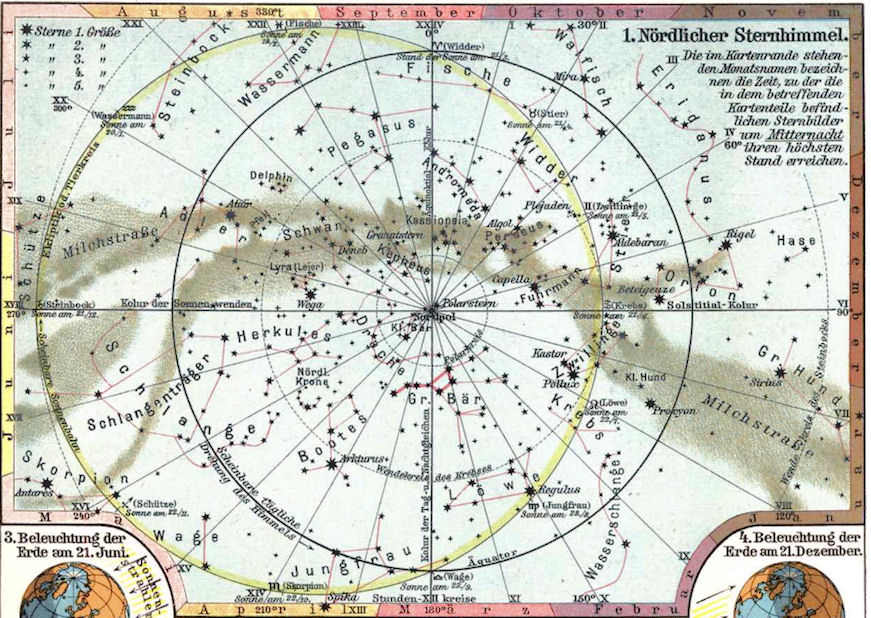
Abb.: Nördlicher Sternhimmel
[Bildquelle: Brockhau's Kleines Konversationslexikon. -- 5. Aufl. -- 1906. --
Public domain]
1 Mondhaus (Nakṣatra)
Siehe:
Payer, Alois <1944 - >: Dharmashastra : Einführung und Überblick. -- 10. Sakramente und Übergangsriten (samskara). -- Anhang A: Mondhäuser (Nakṣatra). -- URL: http://www.payer.de/dharmashastra/dharmash10a.htm
2 Aśvinī und die übrigen
Die 27 Mondhäuser sind:
- Āśvinī (β und γ Arietis [Widder])
- Bhāraṇi (35, 39 und 41 Arietis [Widder])
- Kṛttikā (Pleiades [Plejaden])
- Rohiṇī (α Tauri = Aldebaran)
- Mṛgaśiras (λ, φ1 und φ2 Orionis [Orion])
- Ārdrā (Beteigeuze = α Orionis [Orion])
- Punarvasū (Castor und Pollux = α und β Geminorum [Zwillinge])
- Puṣyā (γ, δ und θ Cancri [Krebs])
- Āśleṣā (δ, ε, η, ρ und σ Hydrae [Wasserschlange])
- Maghā (α, γ, ε, ζ, η und μ Leonis [Löwe])
- Pūrva-phalgunī (δ und θ Leonis [Löwe])
- Uttara-phalgunī (β und 93 Leonis [Löwe])
- Hastā (α, β, γ, δ und ε Corvi [Raabe])
- Citrā (Spica, α Virginis [Jungfrau])
- Svātī (Arcturus [Arktur] = α Bootis [Bootes])
- Viśākhā (α, β, γ und ι Librae [Waage])
- Anurādhā (β, δ und π Scorpionis [Skorpion])
- Jyeṣṭhā (α, σ und τ Scorpionis [Skorpion])
- Mūlā (ε, ζ, η, θ, ι, κ, λ, μ und ν Scorpionis [Skorpion])
- Pūrvāṣādhā (δ und ε Sagittarii [Schütze])
- Uttarāṣādā (ζ und σ Sagittarii [Schütze])
- Śravaṇā (α, β und γ Aquilae [Adler])
- Dhaniṣṭhā bzw. Śraviṣṭhā (α, β, γ und δ Delphinis [Delphin])
- Śatabhiṣaj (γ Aquarii [Wassermann] etc.)
- Pūrva-bhadrapadā (α und β Pegasii [Pegasus])
- Uttara-bhadrapadā (γ Pegasii [Pegasus] und α Andromedae [Andromeda])
- Revatī (ζ Piscium [Fische] etc.)
3 Dākṣāyaṇī's - दाक्षायिणी f., pl.: Töchter des Dakṣa's
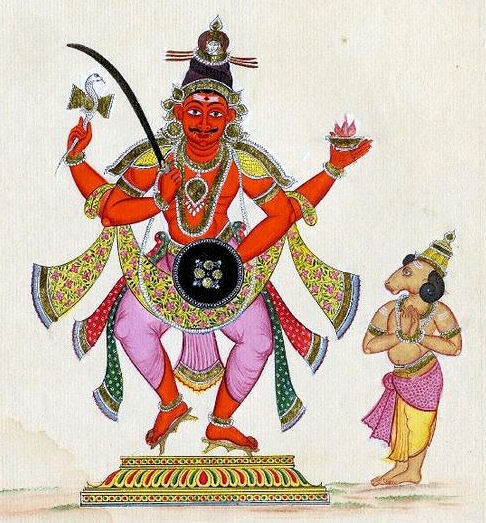
Abb.: Dakṣa (rechts) verehrt Vīrabhadra (Śiva), ca. 1820
[Bildquelle: Wikipedia. -- Public domain]
"According to the Mahā-bhārata, Dakṣa sprang from the right thumb of Brahmā, and his wife from that deity s left thumb. The Purāṇas adopt this view of his origin, but state that he married Prasūti, daughter of Priya-vrata, and grand-daughter of Manu. By her he had, according to various statements, twenty-four, fifty, or sixty daughters. The Rāmāyaṇa and Mahā-bhārata agree in the larger number ; and according to Manu and the Mahā-bhārata he gave ten of his daughters to Dharma and thirteen to Kaśyapa, who became the mothers of gods and demons, men, birds, serpents, and all living things. Twenty-seven were given in marriage to Soma, the moon, and these became the twenty-seven Nakṣatras or lunar mansions."
[Quelle: Dowson, John <1820-1881>: A classical dictionary of Hindu mythology and religion, geography, history, and literature. -- London, Trübner, 1879. -- s.v. ]
4 Aśvinī
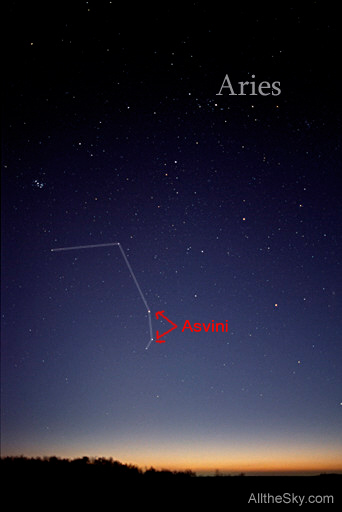
Abb.: Aśvinī = β und γ Arietis [Widder]
[Bildquelle: Till Credner / Wikipedia. -- GNU FDLicense]
5 Viśākhā
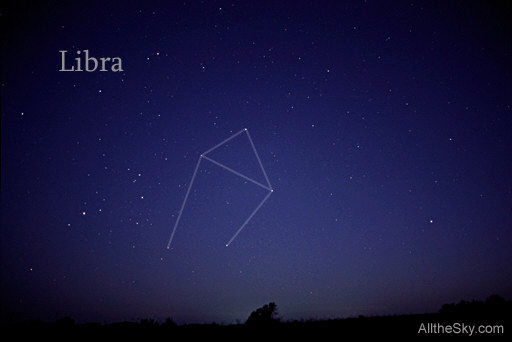
Abb.: Waage (Libra)
[Bildquelle: Till Credner / Wikipedia. -- GNU FDLicense]
Viśākhā = α, β, γ und ι Librae [Waage]
6 Puṣya / Puṣyā
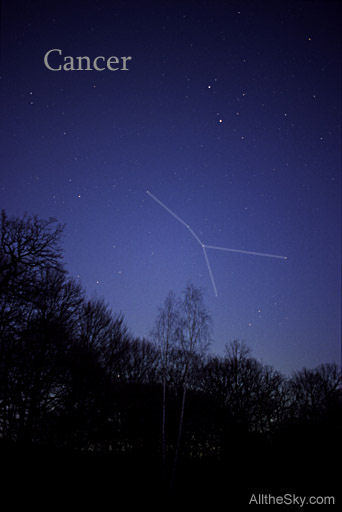
Abb.: Krebs (Cancer)
[Bildquelle: Till Credner / Wikipedia. -- GNU FDLicense]
Puṣyā / Puṣya = γ, δ und θ Cancri [Krebs]
7 Śraviṣṭhā / Dhaniṣṭhā
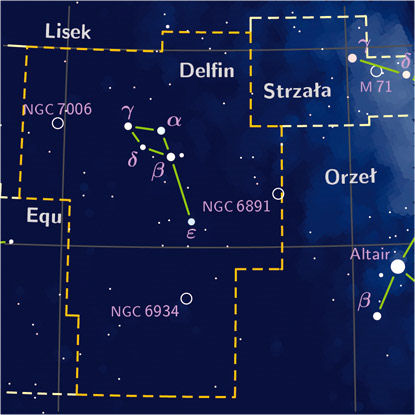
Abb.: Delphin (Delphinus)
[Bildquelle: Blueshade / Wikipedia. -- GNU FDLicense]
Śraviṣṭhā / Dhaniṣṭhā = α, β, γ und δ Delphinis [Delphin]
8 Bhādrapadā - भाद्रपदा f.
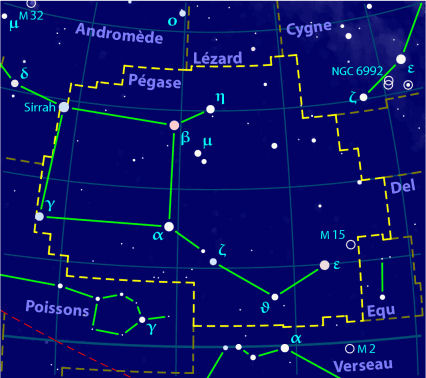
Abb.: Pegasus
[Bildquelle: Orthogaffe / Wikimedia commons. -- GNU FDLicense]
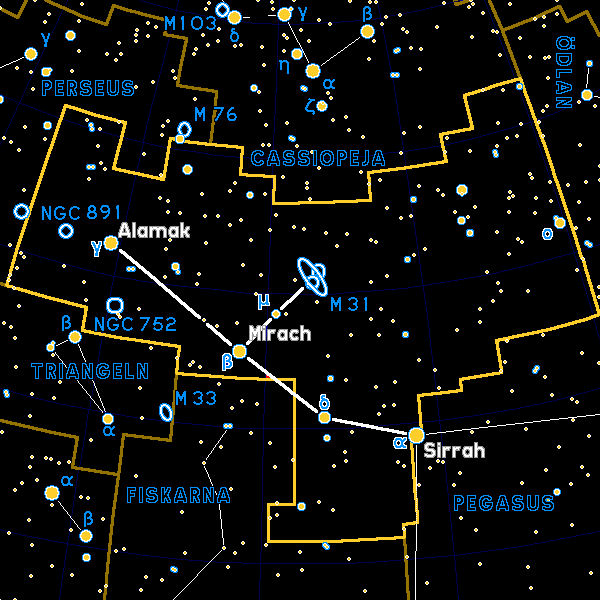
Abb.: Andromeda
[Bildquelle: Draken / Wikimedia commons. -- GNU FDLicense]
Pūrva-bhadrapadā = α und β Pegasii [Pegasus]
Uttara-bhadrapadā = γ Pegasii [Pegasus] und α Andromedae [Andromeda]
24. c./d. bṛhaspatiḥ surācāryo gīṣpatir dhiṣaṇo guruḥ
25 a./b. jīva āṅgiraso vācaspatiś citraśikhaṇḍijaḥ
बृहस्पतिः सुराचार्यो गीष्पतिर् धिषणो गुरुः ॥२४
ख॥
जीव आङ्गिरसो वाचस्पतिर् चित्रशिखण्डिजः ।२५ क।
[Bezeichnungen für den Planeten Jupiter1 sind:]
Erläuterungen:
siehe auch oben!
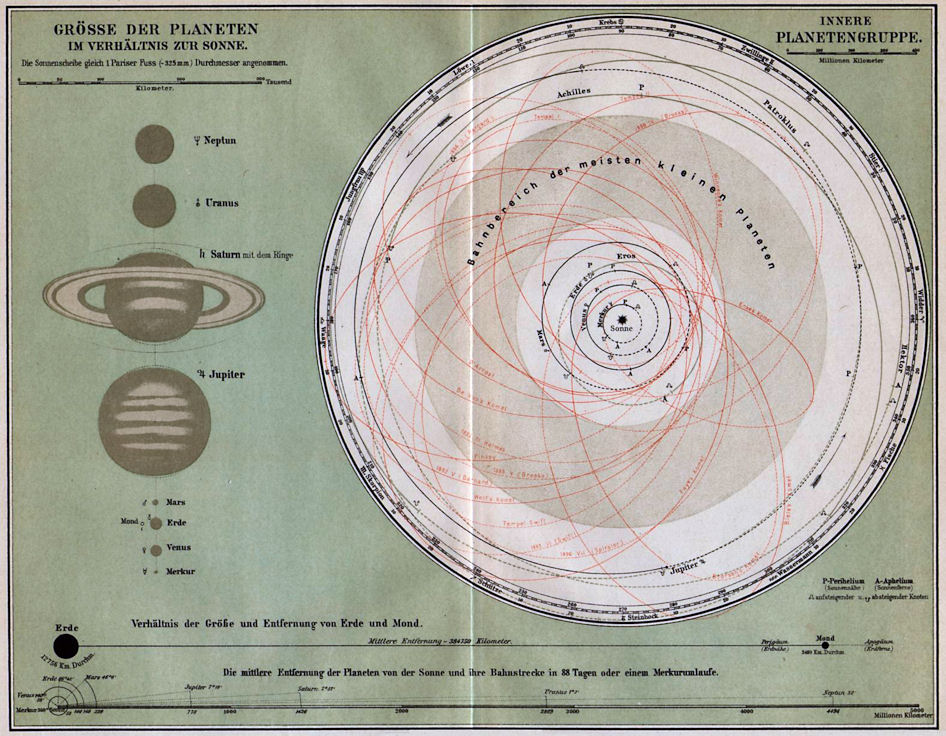
Abb.: Das Planetensystem
[Bildquelle: Meyers großes Konversations-Lexikon.
-- DVD-ROM-Ausg. Faksimile und Volltext der 6. Aufl.
1905-1909. -- Berlin : Directmedia Publ. --2003.
-- 1 DVD-ROM. -- (Digitale Bibliothek ; 100). -- ISBN
3-89853-200-3. -- s.v. -- Public domain]
1 Jupiter
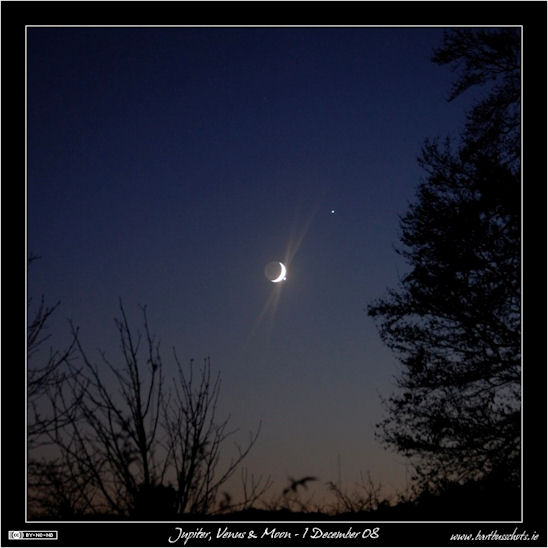
Abb.: Mond mit Venus, Jupiter
[Bildquelle: bbusschots. --
http://www.flickr.com/photos/bbusschots/3078611424/. -- Zugriff am
2010-07-13. --
Creative
Commons Lizenz (Namensnennung, keine kommerzielle Nutzung, keine
Bearbeitung)]
2 Brhaspati - बृहस्पति m.: Bṛhaspati
"BṚHASPATI. In the Ṛg-veda the names Bṛhaspati and Brahmaṇaspati alternate, and are equivalent to each other. They are names "of a deity in whom the action of the worshipper upon the gods is personified. He is the suppliant, the sacrificer, the priest, who intercedes with gods on behalf of men and protects mankind against the wicked. Hence he appears as the prototype of the priests and priestly order; and is also designated as the Purohita (family priest) of the divine community. He is called in one place the father of the gods, and a widely extended creative power is ascribed to him. He is also designated as 'the shining' and 'the gold-coloured', and as 'having the thunder for his voice'."
In later times he is a Ṛṣi. He is also regent of the planet Jupiter, and the name is commonly used for the planet itself. In this character his car is called Nīti-ghoṣa and is drawn by eight pale horses. He was son of the Ṛṣi Aṅgiras, and he bears the patronymic Āṅgirasa. As preceptor of the gods he is called Animiṣācārya, Cakṣas, Ijya, and Indrejya. His wife, Tārā, was carried off by Soma, the moon, and this gave rise to a war called the Tārakā-maya. Soma was aided by Uśanas, Rudra, and all the Daityas and Dānavas, while Indra and the gods took the part of Bṛhaspati. "Earth, shaken to her centre," appealed to Brahmā, who interposed and restored Tārā to her husband. She was delivered of a son which Bṛhaspati and Soma both claimed, but Tārā, at the command of Brahmā to tell the truth, declared Soma to be the father, and the child was named Budha. There is an extraordinary story in the Matsya and Bhāgavata Purāṇas of the Ṛṣis having milked the earth through Bṛhaspati. (See Viṣṇu Purāṇa, i. pp. 188, 190.) Bṛhaspati was father of Bharadvāja by Mamatā, wife of Utathya. (See Bharadvāja.) An ancient code of law bears the name of Bṛhaspati, and he is also represented as being the Vyāsa of the "fourth, Dvāpara age." There was a Ṛṣi of the name in the second Manvantara, and one who was founder of an heretical sect. Other epithets of Bṛhaspati are Jīva, 'the living', Dīdivis, 'the bright', Dhīṣaṇa, 'the intelligent', and, for his eloquence, Gīṣ-pati, 'lord of speech'."
[Quelle: Dowson, John <1820-1881>: A classical dictionary of Hindu mythology and religion, geography, history, and literature. -- London, Trübner, 1879. -- s.v. ]
3 Āṅgirasa - आङ्गिरस m.: Sohn des Aṅgiras
"AṄGIRAS. A Ṛṣi to whom many hymns of the Ṛg-veda are attributed. He was one of the seven Maharṣis or great Ṛṣis, and also one of the ten Prajāpatis or progenitors of man kind. In later times Aṅgiras was one of the inspired lawgivers, and also a writer on astronomy. As an astronomical personification he is Bṛhaspati, the regent of the planet Jupiter, or the planet itself. He was also called the priest of the gods," and "the lord of sacrifice." There is much ambiguity about the name. It comes from the same root as agni, fire, and resembles that word in sound. This may be the reason why the name Aṅgiras is used as an epithet or synonyme of Agni. The name is also employed as an epithet for the father of Agni, and it is found more especially connected with the hymns addressed to Agni, Indra, and the luminous deities. According to one statement, Aṅgiras was the son of Uru by Āgneyī, the daughter of Agni, although, as above stated, the name is sometimes given to the father of Agni. Another account represents that he was born from the mouth of Brahmā. His wives were Smṛti, 'memory', daughter of Dakṣa ; Śrāddhā , 'faith', daughter of Kardama and Svadhā, 'oblation', and Satī, truth, two other daughters of Dakṣa. His daughters were the Ṛcas or Vaidik hymns, and his sons were the Manes called Haviṣmats. But he had other sons and daughters, and among the former were Utathya, Bṛhaspati, and Mārkaṇḍeya. According to the Bhāgavata Purāṇa " he begot sons possessing Brahmanical glory on the wife of Rathī-tara, a Kṣatriya who was childless, and these persons were afterwards called descendants of Angiras."
[Quelle: Dowson, John <1820-1881>: A classical dictionary of Hindu mythology and religion, geography, history, and literature. -- London, Trübner, 1879. -- s.v. ]
25. c./d. śukro daityaguruḥ kāvya uśanā bhārgavaḥ kaviḥ
सुक्रो दैत्यगुरुः काव्य उशना भार्गवः कविः ॥२५ ख॥
[Bezeichnungen für den Planeten Venus1 sind:]
Erläuterungen:
siehe auch oben!
1 Venus
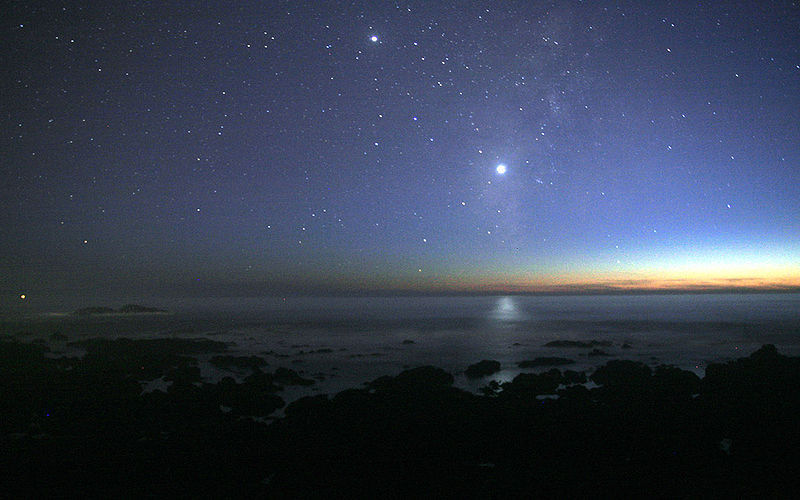
Abb.: Venus erscheint immer heller als die hellsten Sterne
[Bildquelle: Mila Zinkova / Wikipedia. -- GNU FDLicense]
2 Śukra - सुक्र m.: Śukra
"ŚUKRA. The planet Venus and its regent. Śukra was son of Bhṛgu and priest of Bali and the Daityas (Daitya-guru). He is also called the son of Kavi. His wife's name was Śuśumā or Śata-parvā. His daughter Devayānī married Yāyati of the Lunar race, and her husband's infidelity induced Śukra to curse him. Śukra is identified with Uśanas, and is author of a code of law. The Hari-vaṃśa relates that he went to Śiva and asked for means of protecting the Asuras against the gods, and for obtaining his object he performed "a painful rite, imbibing the smoke of chaff with his head downwards for a thousand years." In his absence the gods attacked the Asuras and Viṣṇu killed his mother, for which deed Śukra cursed him "to be born seven times in the world of men." Śukra restored his mother to life, and the gods being alarmed lest Śukra s penance should be accomplished, Indra sent his daughter Jayantī to lure him from it. She waited upon him and soothed him, but he accomplished his penance and afterwards married her. Śukra is known by his patronymic Bhārgava, and also as Bhṛgu. He is also Kavi or Kāvya, 'the poet'. The planet is called Āsphujit, Ἀφροδίτη ; Maghā-bhava, 'son of Maghā'; Ṣodaśāṃśu, 'having sixteen rays' and Śveta, the white."
[Quelle: Dowson, John <1820-1881>: A classical dictionary of Hindu mythology and religion, geography, history, and literature. -- London, Trübner, 1879. -- s.v. ]
3 Daityaguru - दैत्यगुरु m.: Lehrmeister der Daitya
Siehe:
Amarasiṃha <6./8. Jhdt. n. Chr.>: Nāmaliṅgānuśāsana (Amarakośa) / übersetzt von Alois Payer <1944 - >. -- 1. Prathamam kāṇḍam. -- 1. svargavargaḥ. -- URL: http://www.payer.de/amarakosa/amara101.htm
26. a./b. aṅgārakaḥ kujo bhaumo lohitāṅgo mahīsutaḥ
अङ्गारकः कुजो भौमो लोहिताङ्गो महीसुतः ।२६ क।
[Bezeichnungen für den Planeten Mars1 sind:]
Erläuterungen:
siehe auch oben!
1 Mars
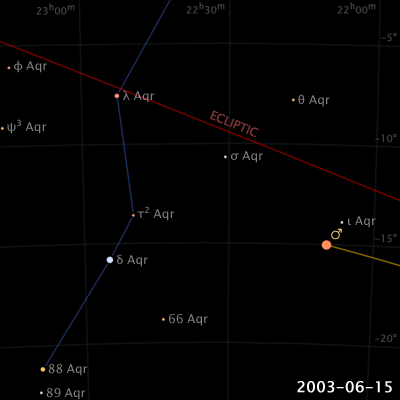
Abb.: Marsbahn
[Bildquelle: Eugene Alvin Villar / Wikimedia commons. --
Creative Commons
Lizenz (Namensnennung, share alike)]
"MAṄGALA. The planet Mars, identified with Kārtikeya, the god of war. He was son of Śiva and the Earth, and as son of the Earth is called Aṅgāraka, Bhauma, Bhūmī-putra, Mahī-suta. He is also called Śiva-gharma-ja, 'born of the sweat of Śiva' ; Gaganolmuka, 'the torch of the sky' ; 'Lohita', the red ; Navārci, 'the nine-rayed' ; Cara, the spy; Ṛṇāntaka, 'ender of debts', patron of debtors. See Kārtikeya."
[Quelle: Dowson, John <1820-1881>: A classical dictionary of Hindu mythology and religion, geography, history, and literature. -- London, Trübner, 1879. -- s.v. ]
2 Aṅgāraka - अङ्गारक m.: Holzkohle, Mars; Lohitāṅga - लोहिताङ्ग m.: Rotgliedriger
Wegen seiner orange- bis blutroten Farbe ("der Rote Planet"). Diese Färbung geht auf Eisen(III)-oxid-Staub (Rost) zurück, der sich auf der Oberfläche und in der Atmosphäre verteilt hat.
26. c./d. rauhiṇeyo budhaḥ saumyaḥ samau
śauri-śanaiścarau
रौहिणेयो बुधः सौम्यः समौ शौरि-शनैश्चरौ ॥२६ ख॥
[Bezeichnungen für den Planeten Merkur1 sind:]
रौहिणेय m.: Sohn der Rohiṇī
बुध m.: der Weise, Merkur2
सौम्य m.: Sohn des Soma (Mond)
[Bezeichnungen für den Planeten Saturn3 sind] gleichbedeutend:
शौरि m.: Sohn des Helden (Sonne)
शनैश्चर m.: langsam Wandelnder4
Erläuterungen:
siehe auch oben!
1 Merkur
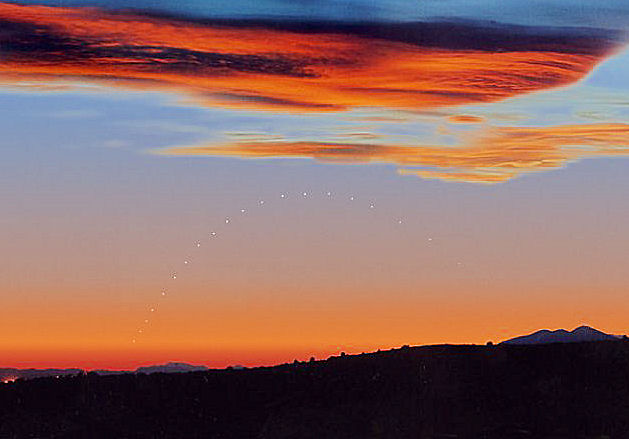
Abb.: Merkur am Horizont
[Bildquelle: NASA. -- Public domain]
2 Budha - बुध m.: der Weise, Merkur
"BUDHA. Wise, intelligent. The planet Mercury, son of Soma, the moon, by Rohiṇī, or by Tārā, wife of Bṛhaspati. (See Bṛhaspati) He married Ilā, daughter of the Manu Vaivasvata, and by her had a son, Purūravas. Budha was author of a hymn in the Ṛig-vecla. (See Ilā.) From his parents he is called Saumya and Rauhineya. He is also called Praharṣaṇa, Rodhana, Tuṅga, and Śyāmāṅga, 'black-bodied'. The intrigue of Soma with Tārā was the cause of a great quarrel, in which the gods and the Asuras fought against each other. Brahmā compelled Soma to give up Tārā, and when she returned to her husband she was pregnant. A son was born, who was so beautiful that Bṛhaspati and Soma both claimed him. Tārā for a long time refused to tell his paternity, and so excited the wrath and nearly incurred the curse of her son. At length, upon the command of Brahmā, she declared Soma to be the father, and he gave the boy the name of Budha. This name is distinct from Buddha."
[Quelle: Dowson, John <1820-1881>: A classical dictionary of Hindu mythology and religion, geography, history, and literature. -- London, Trübner, 1879. -- s.v. ]
3 Saturn
"ŚANI. The planet Saturn. The regent of that planet, represented as a black man in black garments. Śani was a son of the sun and Chāyā, but another statement is that he was the offspring of Bala-rāma and Revatī. He is also known as Āra, Koṇa, and Kroda, and by the patronymic Śaura. His influence is evil, hence he is called Krūra-dṛś and Krūra-locana, 'the evil-eyed one'. He is also Manda, 'the slow' ; Paṅgu, 'the lame'; Sanaiś-cara, 'slow-moving'; Saptārcī, 'seven-rayed'; and Asita, 'the dark'."
[Quelle: Dowson, John <1820-1881>: A classical dictionary of Hindu mythology and religion, geography, history, and literature. -- London, Trübner, 1879. -- s.v. ]
4 Śanaiś-cara - शनैश्चर m.: langsam Wandelnder
Für den menschlichen Beobachter hält sich Saturn ca. 2½ Jahre im gleichen Sternzeichen auf, er bewegt sich also extrem langsam.
27. a./b. tamas tu rāhuḥ svarbhānuḥ saiṃhikeyo vidhuntudaḥ
तमस् तु राहुः स्वर्भानुः सैंहिकेयो विधुन्तुदः ।२७ क।
[Bezeichnungen für Rāhu1 sind:]
1 Rāhu: lauert am aufsteigenden Drachenpunkt (Mondknoten)
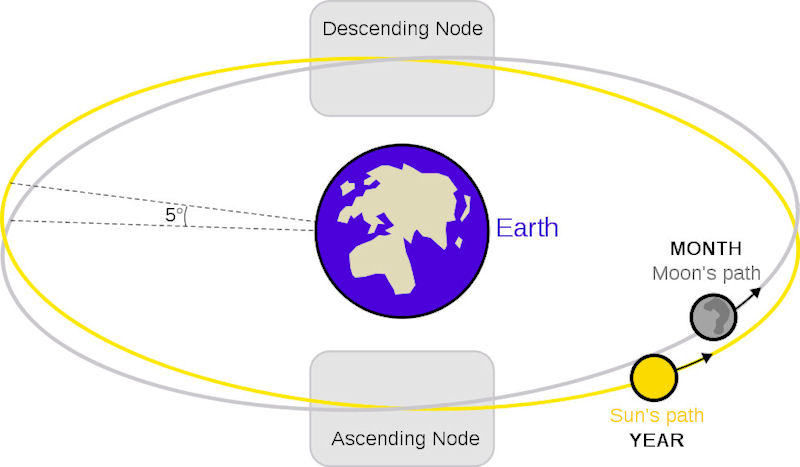
Abb.: Lage von Rāhu und Ketu an den Drachenpunkten (Mondknoten)
[Bildquelle: SuperManu / Wikimedia commons. -- Public domain.]
Siehe auch oben!
Siehe:
Payer, Alois <1944 - >: Dharmashastra : Einführung und Überblick. -- 10. Sakramente und Übergangsriten (samskara). -- Anhang C: Rahu und Ketu, die unsichtbaren Wandelsterne . -- URL: http://www.payer.de/dharmashastra/dharmash10c.htm
"Die Mondknoten oder Drachenpunkte sind die Schnittpunkte der Mondbahn mit der Ekliptikebene. Der aufsteigende Mondknoten (übliches Symbol: ☊) ist derjenige, bei dem der Mond von der südlichen auf die nördliche Seite der Ekliptik wechselt. Im absteigenden Mondknoten (☋) wechselt der Mond auf die Südseite der Ekliptik. Die Verbindung der beiden Knoten heißt Knotenlinie.
Knotenpunkte und FinsternisseNur in der Nähe eines Durchgangs des Mondes durch einen der Knoten – bei gleichzeitigem Voll- oder Neumond – ist eine Mond- bzw. Sonnenfinsternis möglich. Das Zeitintervall zwischen zwei Durchgängen der Sonne durch denselben Mondknoten bezeichnet man als Finsternisjahr.
Von dem Bild des Drachens, der die Sonne bzw. den Mond verschluckt, leitet sich der alte Ausdruck Drachenpunkt (lateinisch draco „Drache“) ab: Die Mondknoten waren auch als Drachenkopf (Caput draconis, aufsteigender Mondknoten) bzw. Drachenschwanz (Cauda draconis, absteigender Mondknoten) bekannt und besaßen eine besondere Bedeutung. Dieselbe etymologische Bedeutung steckt in der „Ekliptik“ (griechisch éκlιpsi – wörtlich „Verdeckung, Auslöschung“)."
[Quelle: http://de.wikipedia.org/wiki/Mondknoten. -- Zugriff am 2010-07-13]
"RĀHU. Rāhu and Ketu are in astronomy the ascending and descending nodes. Rāhu is the cause of eclipses, and the term is used to designate the eclipse itself. He is also considered as one of the planets, as king of meteors, and as guardian of the south-west quarter. Mythologically Rāhu is a Daitya who is supposed to seize the sun and moon and swallow them, thus obscuring their rays and causing eclipses. He was son of Vipracitti and Sinhikā, and is called by his metronymic Sainhikeya. He had four arms, and his lower part ended in a tail. He was a great mischief-maker, and when the gods had produced the Amṛta by churning the ocean, he assumed a disguise, and insinuating himself amongst them, drank some of it. The sun and moon detected him and informed Viṣṇu, who cut off his head and two of his arms, but, as he had secured immortality, his body was placed in the stellar sphere, the upper parts, represented by a dragon s head, the ascending node, and the lower parts, represented by a dragon s tail, being Ketu the descending node. Rāhu wreaks his vengeance on the sun and moon by occasionally swallowing them. The Viṣṇu Purāṇa says, "Eight black horses draw the dusky chariot of Rāhu, and once harnessed are attached to it for ever. On the Parvans (nodes, or lunar and solar eclipses) Rāhu directs his course from the sun to the moon, and back again from the moon to the sun. The eight horses of the chariot of Ketu, swift as the wind, are of the dusky red colour of lac, or of the smoke of burning straw." Rāhu is called Abhra-piśāca, 'the demon of the sky' ; Bharaṇī-bhū, 'born from the asterism Bharaṇī'; Graha, 'the seizer' ; Kabandha, 'the headless'."
[Quelle: Dowson, John <1820-1881>: A classical dictionary of Hindu mythology and religion, geography, history, and literature. -- London, Trübner, 1879. -- s.v. ]
27. c./d. saptarṣayo marīcy-atri-mukhāś citraśikhaṇḍinaḥ
सप्तर्षयो मरीच्य्-अत्रि-मुखाश् चित्रसिखण्डिनः ॥२७ ख॥
Die sieben Ṛṣis (सप्तर्षि m.)1 - Marīci, Atri und die übrigen2 - heißen auch Citraśikhaṇḍin's - चित्रशिखण्डिन् m.: die mit glänzenden Locken
Erläuterungen:
1 sieben Ṛṣis (सप्तर्षि m.) = Großer Bär / Wagen
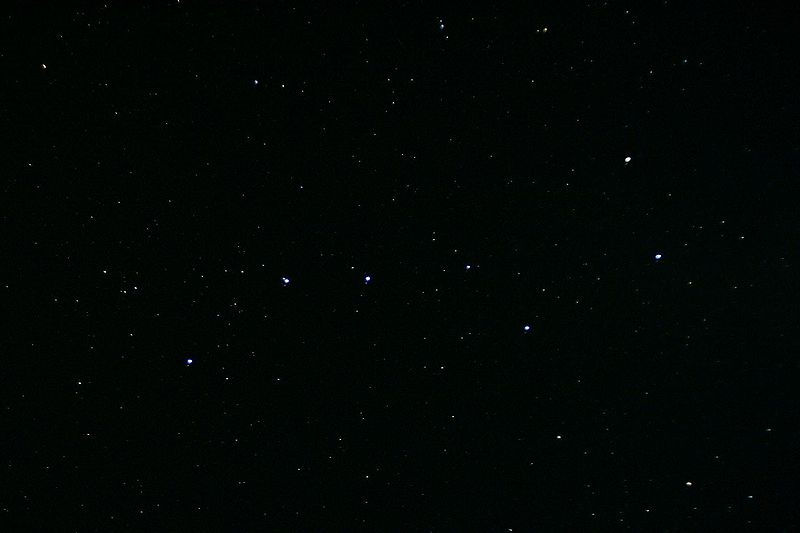
Abb.: Großer Wagen
[Bildquelle: Eclipse / Wikipedia. -- GNU FDLicense]
"Bär (Bärin), zwei Sternbider am nördlichen Himmel. Der Große B. (Ursa major) oder der Wagen wird von 7 Sternen (sechs zweiter, einer dritter Größe) gebildet, von denen 4 in Form eines länglichen, ungleichseitigen Vierecks den hintern Leib des Bären (die Räder des Wageus) darstellen, 3 in gekrümmter Linie den Schwanz des Bären (Deichsel des Wagens). Der Stern am Ende des Schwanzes heißt Benetnasch (η Ursae majoris), der mittelste Schwanzstern Mizar (ζ), über dem in 12´ Entfernung, einem scharfen Auge wohl erkennbar, ein kleiner Stern 5. Größe, Alkor (g) oder das Reiterchen, steht; Mizar hat aber auch noch in 15´´ Abstand einen Begleiter 4. Größe und ist selbst ein spektroskopischer Doppelstern (vgl. Fixsterne), so dass derselbe ein dreifaches System darstellt. Der vorderste Schwanzstern ist Alioth (e), der oberste und von dem Schwanz entfernteste Rückenstern Dubhe (α). Nach der griechischen Mythe wurde ð Kallisto (s. d.), nachdem sie vom Zeus den Arkas geboren hatte, von der Hera in eine Bärin verwandelt, dann von Zeus unter die Sterne versetzt. Im Altertum hießen die 7 Hauptsterne auch Septentriones und Boves Icarii, bei den Arabern die 4 Rumpfsterne Nasch (»Bahre«) und die Schwanzsterne Benetnasch (»Töchter der Bahre«, d. h. Leidtragende), der äußerste Stern Elkaid (»Statthalter«). Der hebräische Name des Sternbildes ist Asch (»Bahre«)." [Quelle: Meyers großes Konversations-Lexikon. -- DVD-ROM-Ausg. Faksimile und Volltext der 6. Aufl. 1905-1909. -- Berlin : Directmedia Publ. --2003. -- 1 DVD-ROM. -- (Digitale Bibliothek ; 100). -- ISBN 3-89853-200-3. -- s.v.]
Die westlichen Namen der sieben Sterne des Großen Wagens:
Proper
NameBayer
DesignationApparent
MagnitudeDistance
(L Yrs)Dubhe α UMa 1.8 124 Merak β UMa 2.4 79 Phecda γ UMa 2.4 84 Megrez δ UMa 3.3 81 Alioth ε UMa 1.8 81 Mizar ζ UMa 2.1 78 Alkaid η UMa 1.9 101
2 Marīci, Atri und die übrigen
"ṚṢI. An inspired poet or sage. The inspired persons to whom the hymns of the Vedas were revealed, and under whose names they stand. The seven Ṛṣis (saptarṣi), or the Prajā-patis, the mind-born sons of Brahma, are often referred to.
In the Śatapatha Brāhmaṇa their names are given as
Gotama
Bharadvāja
Viśvāmitra
Jamad-agni
Vasiṣṭha
Kaśyapa, and
Atri.
The Mahā-bhārata gives them as
Marīci
Atri
Aṅgiras
Pulaha
Kratu
Pulastya, and
Vasiṣṭha.
The Vāyu Purāṇa adds Bhṛgu to this list, making eight, although it still calls them "seven."
The Viṣṇu Purāṇa, more consistently, adds Bhṛgu and Dakṣa, and calls them the nine Brahmarṣis (Brahma-ṛṣis).
The names of Gautama, Kaṇva, Vālmīki, Vyāsa, Manu, and Vibhāṇḍaka are also enumerated among the great Ṛṣis by different authorities.
Besides these great Ṛṣis there are many other Ṛṣis.
The seven Bishis are represented in the sky by the seven stars of the Great Bear, and as such are called Ṛkṣa and Citra-śikhaṇḍinas, 'having bright crests'."
[Quelle: Dowson, John <1820-1881>: A classical dictionary of Hindu mythology and religion, geography, history, and literature. -- London, Trübner, 1879. -- s.v. ]
28. a./b. rāśīnām udayo lagnaṃ te tu meṣa-vṛṣādayaḥ
राशीनाम् उदयो लग्नं ते तु मेष-वृषादयः ।२८ क।
Der Aufstieg der Sterngruppen (राशि m.) (des Tierkreises1) heißt lagna - लग्न n. (Aszendent). Die Sterngruppen (des Tierkreises) heißen Meṣa, Vṛṣa usw.2
Erläuterungen:
1 Tierkreis
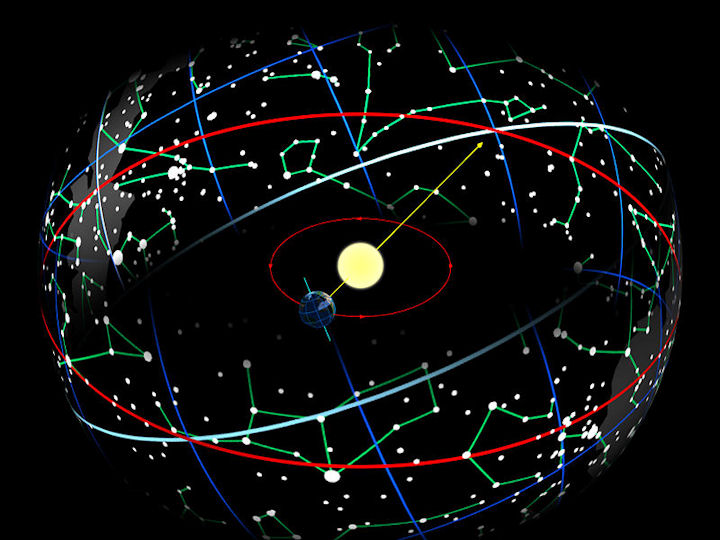
Abb.: Scheinbarer Weg der Sonne im Jahreslauf durch
den Tierkreis
[Bildquelle: Tauʻolunga / Wikipedia. -- GNU FDLicense]
2 Meṣa, Vṛṣa usw.
Sanskrit Name Lateinischer Name Deutscher Name 1 Meṣa m. "Widder" Aries Widder 2 Vṛṣabha m. "Stier" Taurus Stier 3 Mithuna m. "Paar" Gemini Zwillinge 4 Karkaṭa m. "Krebs" Cancer Krebs 5 Siṃha m. "Löwe" Leo Löwe 6 Kanyā f. "Jungfrau" Virgo Jungfrau 7 Tulā f. "Waage" Libra Waage 8 Vṛścika m. "Skorpion" Scorpio Skorpion 9 Dhanus n. "Bogen" Sagittarius Schütze 10 Makara m. "Makara" Capricorn Steinbock 11 Kumbha m. "Topf" Aquarius Wassermann 12 Mīna m. "Fisch" Pisces Fische
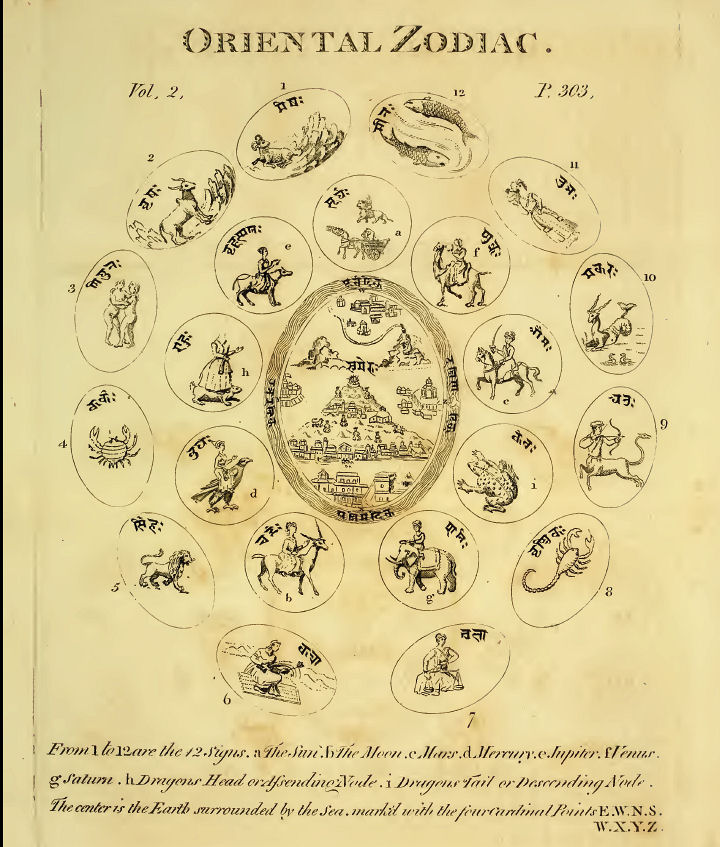
Abb.: Der indische Tierkreis
[Bildquelle: Asiatick Researches II (1799). -- Vor S. 303]
28. c./d. sūra-sūryāryamāditya-dvādaśātma-divākarāḥ
29. bhāskarāhaskara-bradhna-prabhākara-vibhākarāḥ
bhāsvad-vivasvat-saptāśva-haridaśvoṣṇaraśmayaḥ
30. vikartanārka-mārtaṇḍa-mihirāruṇa-pūṣaṇaḥ
dyumaṇis taraṇir mitraś citrabhānur virocanaḥ
31. vibhāvasur grahapatis tviṣāṃpatir aharpatiḥ
bhānur haṃsaḥ sahasrāṃśus tapanaḥ savitā raviḥ
32. padmākṣas tejasāṃrāśiś chāyānāthas tamisrahā
karmasākṣī jagaccakṣur lokabandhus trayītanuḥ
33. pradyotano dinamaṇiḥ khadyoto lokabāndhavaḥ
ino bhago bhāmanidhiś cāṃśumāly abjinīpatiḥ
सूर-सूर्यार्यमादित्य-द्वादशात्म-दिवाकराः ॥२८ ख॥
भास्कराहस्कर-ब्रध्न-प्रभाकर-विभाकराः ।
भास्वद्-विवस्वत्-सप्ताश्व-हरिदश्वोष्णरश्मयः ॥२९॥
विकर्तनार्क-मार्तण्ड-मिहिरारुण-पूषणः ।
द्युमणिस् तरणिर् मित्रश् चित्रभानुर् विरोचनः ॥३०॥
विभावसुर् ग्रहपतिस् त्विषांपतिर् अहर्पतिः ।
भानुर् हंसः सहस्रांशुस् तपनः सविता रविः ॥३१॥
पद्माक्षस् तेजसांराशिश् छायानाथस् तमिस्रहा ।
कर्मसाक्षी जगच्चक्षुर् लोकबन्धुस् त्रयीतनुः ॥३२॥
प्रद्योतनो दिनमणिः खद्योतो लोकबान्धवः ।
इनो भगो भामनिधिश् चांशुमाल्य्
अब्जिनीपतिः ॥३३॥
[Bezeichnungen für Sonne1 sind:]
1 Sonne
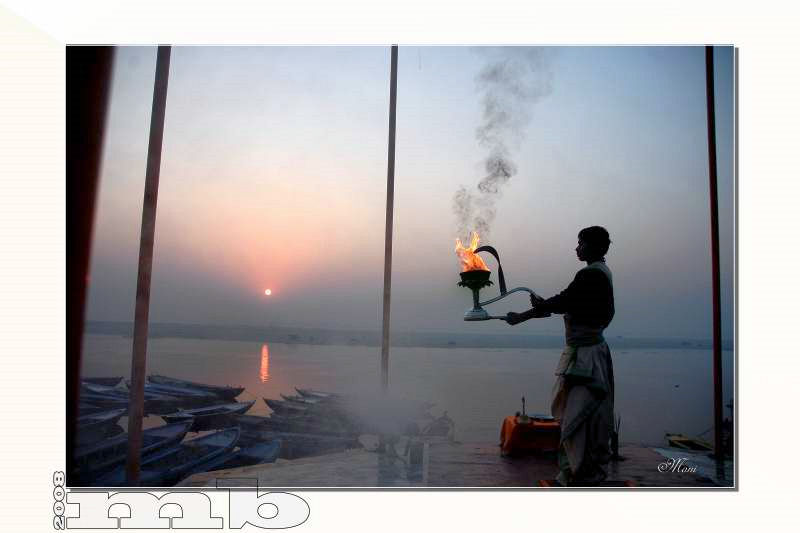
Abb.: Sonnenaufgang am Ganges, Varanasi (वाराणसी), UP
[Bildquelle: ~FreeBirD®~. --
http://www.flickr.com/photos/maniya/2518398294/. -- Zugriff am 2010-07-13.
-- Creative
Commons Lizenz (Namensnennung, keine kommerzielle Nutzung, keine
Bearbeitung)]
2 Sūrya - सूर्य m.: Sonne
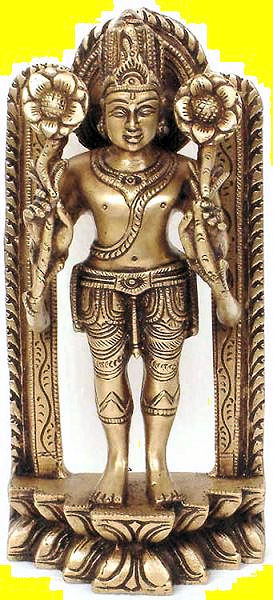
Abb.: Sūrya
[Bildquelle: Softdynamite / Wikipedia. -- GNU FDLicense]
"SŪRYA. The sun or its deity. He is one of the three chief deities in the Vedas, as the great source of light and warmth, but the references to him are more poetical than precise. Some times he is identical with Savitṛ and Āditya, sometimes he is distinct. "Sometimes he is called son of Dyaus, sometimes of Aditi. In one passage, Uṣas, the dawn, is his wife, in another he is called the child of the dawns ; he moves through the sky in a chariot drawn by seven ruddy horses or mares." Sūrya has several wives, but, according to later legends, his twin sons the Aśvins, who are ever young and handsome and ride in a golden car as precursors of Uṣas, the dawn, were born of a nymph called Aśvinī, from her having concealed herself in the form of a mare. In the Rāmāyaṇa and Purāṇas, Sūrya is said to be the son of Kaśyapa and Aditi, but in the Rāmāyaṇa he is otherwise referred to as a son of Brahmā. His wife was Sañjñā, daughter of Viśva-karma, and by her he had three children, the Manu Vaivasvata, Yama, and the goddess Yamī, or the Yamunā river. His effulgence was so overpowering that his wife gave him Chāyā (shade) for a handmaid, and retired into the forest to devote herself to religion. While thus engaged, and in the form of a mare, the sun saw her and approached her in the form of a horse. Hence sprang the two Aśvins and Revanta. Sūrya brought back his wife Sañjñā to his home, and her father, the sage Viśva-karma, placed the luminary on his lathe and cut away an eighth of his effulgence, trimming him in every part except the feet. The fragments that were cut off fell blazing to the earth, and from them Viśva-karma formed the discus of Viṣṇu, the trident of Śiva, the weapon of Kuvera, the lance of Kārttikeya, and the weapons of the other gods. According to the Mahā-bhārata, Karṇa was his illegitimate son by Kuntī. He is also fabled to be the father of Śani and the monkey chief Sugrīva. The Manu Vaivasvata was father of Ikṣvāku, and from him, the grandson of the sun, the Sūrya-vaṃśa, or Solar race of kings, draws its origin. In the form of a horse Sūrya communicated the White Yajur-veda to Yajñavalkya, and it was he who bestowed on Satrajit the Syamantaka gem. A set of terrific Rākṣasas called Mandehas made an attack upon him and sought to devour him, but were dispersed by his light. According to the Viṣṇu Purāṇa he was seen by Sattrājita in "his proper form," "of dwarfish stature, with a body like burnished copper, and with slightly reddish eyes." Sūrya is represented in a chariot drawn by seven horses, or a horse with seven heads, surrounded with rays. His charioteer is Aruṇa or Vivasvat, and his city Vivaswatī or Bhāswatī. There are temples of the sun, and he receives worship. The names and epithets of the sun are numberless. He is Savitṛ, 'the nourisher' ; Vivasvat, 'the brilliant' ; Bhāskara, 'light-maker' ; Dina-kara, 'day-maker' ; Arha-pati, 'lord of day' ; Loka-cakṣuḥ, 'eye of the world' ; Karma-sākṣī, 'witness of the deeds (of men)' ; Graha-rāja, 'king of the constellations' ; Gabhastimān, 'possessed of rays' ; Sahasra-kiraṇa, 'having a thousand rays' ; Vikarttana, 'shorn of his beams' (by Viśva-karma); Mārtaṇḍa, 'descended from Mṛtaṇḍa' &c. Sūrya s wives are called Savarṇā, Svātī, and Mahā-vīryā."
[Quelle: Dowson, John <1820-1881>: A classical dictionary of Hindu mythology and religion, geography, history, and literature. -- London, Trübner, 1879. -- s.v. ]
3 Āditya - आदित्य m.: Sohn der Aditi
"Aditi. 'Free, unbounded. Infinity'; the boundless heaven as compared with the finite earth ; or, according to M. Müller, "the visible infinite, visible by the naked eye; the endless expanse beyond the earth, beyond the clouds, beyond the sky." In the Ṛg-veda she is frequently implored "for blessings on children and cattle, for protection and for forgiveness." Aditi is called Deva-mātṛ, mother of the gods, and is represented as being the mother of Dakṣa and the daughter of Dakṣa. On this statement Yaska remarks in the Nirukta : "How can this be possible ? They may have had the same origin ; or, according to the nature of the gods, they may have been born from each other, have derived their substance from one another." "Eight sons were born from the body of Aditi ; she approached the gods with seven but cast away the eighth, Mārtāṇḍa (the sun)." These seven were the Ādityas. In the Yajur-veda Aditi is addressed as "Supporter of the sky, sustainer of the earth, sovereign of this world, wife of Viṣṇu ;" but in the Mahābhārata and Rāmāyaṇa, as well as in the Purāṇas, Viṣṇu is called the son of Aditi. In the Viṣṇu Purāṇa she is said to be the daughter of Dakṣa and wife of Kaśyapa, by whom she was mother of Viṣṇu, in his dwarf incarnation (wherefore he is sometimes called Āditya), and also of Indra, and she is called "the mother of the gods"; and "the mother of the world." Indra acknowledged her as mother, and Viṣṇu, after receiving the adoration of Aditi, addressed her in these words : "Mother, goddess, do thou show favour unto me and grant me thy bless ing." According to the Matsya Purāṇa a pair of ear-rings was produced at the churning of the ocean, which Indra gave to Aditi, and several of the Purāṇas tell a story of these ear-rings being stolen and carried off to the city of Prāg-jyotiṣa by the Asura king Naraka, from whence they were brought back and restored to her by Kṛṣṇa. Devakī, the mother of Kṛṣṇa, is represented as being a new birth or manifestation of Aditi. See Max Müller's Ṛg Veda, i. 230; Muir's Texts, iv. n, v. 35." [Quelle: Dowson, John <1820-1881>: A classical dictionary of Hindu mythology and religion, geography, history, and literature. -- London, Trübner, 1879. -- s.v. ]
4 Dvādaśātman - द्वादशात्मन् m.: der zwölf Seelen hat
Jātarūpa zitiert dazu folgenden Vers:
इन्द्रो धाताथ पर्जन्यस् त्वष्टा पूषार्यमा भगः ।
विवस्वान् विष्णुर् अंशुश् च मित्रो वरुण एव च ॥[Die zwölf Seelen / Erscheinungsformen der Sonne sind:]
- इन्द्र m.: Indra
- धातृ m.: Dhātṛ
- पर्जन्य m.: Parjanya
- त्वष्टृ m.: Tvaṣṭṛ
- पूषन् m.: Pūṣan
- अर्यमन् m.: Aryaman
- भग m.: Bhaga
- विवस्वन्त् m.: Vivasvant
- विष्णु m.: Viṣṇu
- अंशु m.: Aṃśu
- मित्र m.: Mitra
- वरुण m.: Varuṇa
5 Haṃsa -हंस m.: Entenvogel (Anatida)
haṃsa ist ein generischer Ausdruck für einen großen Teil der Anatidae-Familie (Entenvögel), also für Gänse, Enten und Schwäne (heute kommen in Indien außerhalb des Himalaya keine Schwäne vor!). Hier ist an einen weißen Vertreter dieser Familie gedacht.
6 Padmākṣa - पद्माक्ष m.: Lotosauge
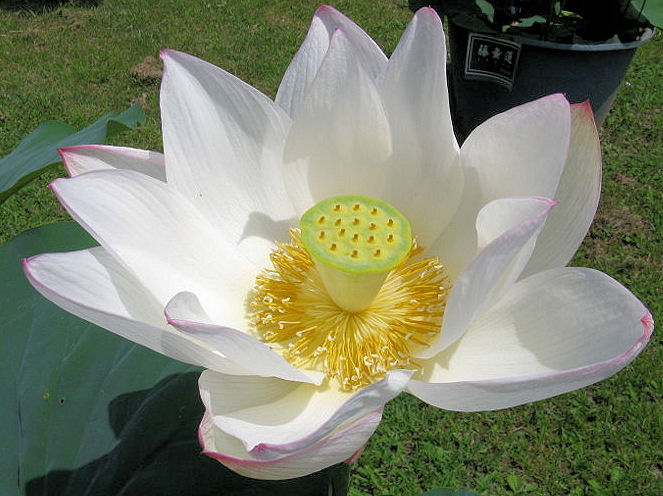
Abb.: padma - Nelumbo nucifera Gaertn. - Indische Lotosblume
[Bildquelle: KENPEI / Wikimedia commons. -- GNU FDLicense]
7 Chāyānātha - छायानाथ m.: Schutzherr des Schattens, Schutzherr der Chāyā
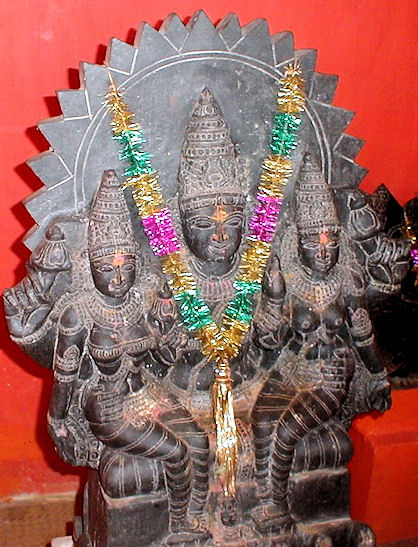
Abb.: Sūrya mit Saṃjñā und Chāyā, Kunda Satyanarayana Kala Dhamam - Mythological
Awareness Center (సురేంద్రపురి హనుమదీశ్వర ఆలయం), Surendrapuri, Andhra Pradesh
[Bildquelle: Redtigerxyz (derivative work of an original by Akrishna) /
Wikipedia. --
Creative Commons Lizenz (Namensnennnung, share alike)]
"CHĀYĀ. 'Shade'. A handmaid of the sun. Saṃjñā, wife of the sun, being unable to bear the fervour of her lord, put her handmaid Chhaya in her place. The sun, believing Chāyā, to be his wife, had three children by her : Śani, the planet Saturn ; the Manu Sāvarṇi ; and a daughter, the Tapatī river. As mothe of Saturn, Chāyā is known as Śani-prasū. The partiality which she showed for these children provoked Yama, the son of Saṃjñā, and he lifted his foot to kick her. She cursed him to have his leg affected with sores and worms. This made it clear that she was not Saṃjñā and mother of Yama, so the sun went in search of Saṃjñā and brought her back. According to one Purāṇa, Chāyā was a daughter of Viśvakarma, and sister of Saṃjñā, the wife of the sun."
[Quelle: Dowson, John <1820-1881>: A classical dictionary of Hindu mythology and religion, geography, history, and literature. -- London, Trübner, 1879. -- s.v. ]
8 Abjinīpati - अब्जिनीपति m.: Herr der lotusreichen Plätze

Abb.: Nelumbo nucifera Gaertn. - Indische Lotosblumen, Chennai
[Bildquelle: flickrPrince. --
http://www.flickr.com/photos/prince_tigereye/1464693202/. -- Zugriff am
2010-07-14. --
Creative Commons Lizenz (Namensnennung)]
34. māṭharaḥ piṅgalo daṇḍaś caṇḍāṃśoḥ paripārśvakāḥ
sūrasūto 'ruṇo 'nūruḥ kāśyapir garuḍāgrajaḥ
35. pariveṣas tu paridhir upasūryaka-maṇḍale
kiraṇosra-mayūkhāṃśu-gabhasti-ghṛṇi-raśmayaḥ
36. bhānuḥ karo marīciḥ strīpuṃsayor dīdhitiḥ striyām
syuḥ prabhā rug rucis tviḍ-bhā-bhāś-chavi-dyuti-dīptayaḥ
37. a./b. rociḥ śocir ubhe klībe prakāśo dyota ātapaḥ
माठरः पिङ्गलो दण्डश् चण्डांशोः परिपार्श्वकाः ।
सूरसूतो
ऽरुणो
ऽनूरुः काश्यपिर् गरुडाग्रजः
॥३४॥
परिवेषस् तु परिधिर् उपसूर्यक-मण्डले ।
किरणोस्र-मयूखांशु-गभस्ति-घृणि-रश्मयः ॥३५॥
भानुः करो मरीचिः स्त्रीपुंसयोर् दीधितिः स्त्रियां ।
स्युः प्रभा रुग् रुचिस्
त्विड्-भा-भाश्-छवि-द्युति-दीप्तयः ॥३६॥
रोचिः शोचिर् उभे क्लीबे प्रकाशो द्योत आतपः ।३७
क।
Dem ungestüm Strahlenden (Sonne) stehen als Diener zur Seite1:
[Bezeichnungen für Morgenröte2 sind:]
[Bezeichnungen für Sonnen-Hof4 sind:]
[Bezeichnungen für Sonnenstrahl5 sind:]
[Bezeichnungen für Lichtglanz sind:]
Erläuterungen:
1 als Diener zur Seite
Jātarūpa zitiert dazu folgenden Vers:
तत्र शक्रो वामपार्श्वे दण्डाख्यो दण्डनायकः ।
वह्निस्तु दक्षिणे पार्श्वे पिङ्गलो वामनश् च सः ॥"Dort ist Śakra (Indra) auf der linken Seite (der Sonne) und der Daṇḍa ("Strafstock") genannte Führer des Strafstocks (Yama), das Feuer (Agni) aber ist auf der rechten Seite der Sonne, er (Agni) wird der Rote (Piṇgala) und Zwerg (Vāmana) genannt."
2 Aruṇa - अरुण m.: Morgenröte
"ARUṆA. 'Red, rosy'. The dawn, personified as the charioteer of the sun. This is of later origin than the Vedic Uṣas (q.v.). He is said to be the son of Kaśyapa and Kadru. He is also called Rumra, 'tawny', and by two epithets of which the meaning is not obvious, An-ūru, 'thighless', and Āśmana, stony."
[Quelle: Dowson, John <1820-1881>: A classical dictionary of Hindu mythology and religion, geography, history, and literature. -- London, Trübner, 1879. -- s.v. ]
3 Sūrasūta - सूरसूत m.: Herold / Liedermacher / Wagenlenker der Sonne
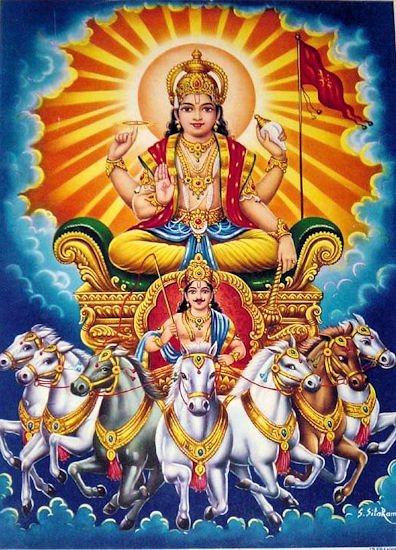
Abb.: Aruṇa als Wagenlenker (sūta) der Sonne, um 1940
[Bildquelle: Wikipedia. -- Public domain]
4 Hof

Abb.: Hof um Sonne, San Francisco, USA
[Bildquelle: Mila Zinkova / Wikipedia. -- Public domain]
"Hof, ein weißlicher oder farbiger Kreis um die Sonne oder den Mond. Man unterscheidet kleinere und größere Höfe, von denen die letztern oft in Verbindung mit Nebensonnen oder Nebenmonden und andern Lichterscheinungen auftreten. Die kleinern Höfe (Lichtkränze, Coronac, Aureolen, H in der Abbildung) entstehen, wenn dünne niedrige Wolken an dem Gestirn vorüberziehen oder die Luft stark wasserdampfhaltig ist. Der leuchtende Körper ist zunächst von einem gräulichblauen Kreis umgeben. der außen von einem gelben und roten Kreis begrenzt ist.
Höfe, Nebensonnen, Nebenmonde, etc.Auf diese folgen zuweilen noch anders gefärbte Kreise, die nach außen hin abwechselnd grün und rot sind. In dieser Vollständigkeit erscheinen die Höfe nur selten, meist sind die Farben nur schwach oder verschwinden ganz, so dass dann nur ein H. als heller Schein ohne Farben oder, wie oft beim Monde, mit braunrotem Rande sichtbar ist. Die Durchmesser der farbigen Ringe betragen wenige Grade und sind nach der Größe der Wassertröpfchen verschieden; je größer diese, desto kleiner jene, und man kann die Größe der Tröpfchen aus dem Durchmesser der Ringe berechnen. Die kleinern Höfe werden durch die Beugung der Lichtstrahlen (s. ð Beugung des Lichtes) an den Tröpfchen hervorgerufen und lassen sich nachahmen, wenn man eine Flamme durch ein schwach angehauchtes oder mit seinem Staub (Semen Lycopodii) bestreutes Glas betrachtet. Die größern Höfe (Sonnen-, Mondringe, griech.-lat. Halo) zeigen sich in ihrer einfachsten Form als helle, zuweilen als farbige Kreise, in deren Mittelpunkt der leuchtende Körper steht. Ihr Radius hat entweder eine Größe von 22–23° (R, der obenstehenden Abbildung) oder von 46–47° (R2), der innere Rand ist schärfer, der äußere mehr verwaschen, und wenn Farben sichtbar sind, befindet sich das Rot auf der innern Seite. Zu diesem einfachen Kreis treten öfters noch andre Erscheinungen hinzu. Zunächst ist ein horizontaler heller Streifen zu nennen, der sich in gleicher Höhe mit der Sonne hinzieht. Da, wo dieser Horizontalkreis (K, Nebensonnenkreis) den Ring schneidet (genauer etwa 2° nach außen), ist er am hellsten; diese hellen Stellen heißen Nebensonnen und Nebenmonde (Ne und Nr). Bisweilen erscheinen Nebensonnen auch senkrecht über (No) oder unter (Nu) der Sonne am höchsten und tiefsten Punkte des Sonnenringes, oder es zeigt sich an diesen Stellen ein Berührungsbogen (B1 und B2) von entgegengesetzter Krümmung als der Sonnenring. Oft sind von der ganzen Erscheinung nur die Nebensonnen ohne irgend welche Kreise sichtbar, und endlich zeigt sich zuweilen auch ein der Sonne genau gegenüberstehender und mit derselben in gleicher Höhe befindlicher weißer Fleck, eine Gegensonne (Anthelien), der im horizontalen Streifen steht, wenn dieser sichtbar ist. Man sieht diese Erscheinungen der größern Höfe am häufigsten während der kältern Jahreszeit und in nördlichen Gegenden. Besonders schöne und vollständige Erscheinungen sind unter dem Namen des römischen, Petersburger und Danziger Phänomens bekannt. Die Ringe, deren Halbmesser 22° beträgt, entstehen aus einer Brechung der Lichtstrahlen in sechs- oder dreiseitigen Prismen der in der Luft schwebenden Eiskristalle, deren brechender Winkel 60° beträgt; das unter kleinerm Winkel reflektierte Licht gelangt nicht in unser Auge, weshalb der Innenraum der Höfe dunkler ist als der äußere. Die größern Kreise oder Ringe entstehen durch eine Brechung der Lichtstrahlen in sechsseitigen Prismen, bei denen der rechte Winkel, den die Seitenflächen des Prismas mit seiner Basis bilden, der brechende Winkel ist. Den horizontalen Nebensonnenkreis erklärt man durch die Reflexion der Sonnenstrahlen an den senkrechten Flächen der Eiskristalle sowie die Entstehung der Nebensonnen dadurch, daß die Schnittpunkte der Sonnenkreise und des horizontalen Streifens am hellsten sein müssen, weil hier zwei Ursachen für die Erleuchtung zusammenwirken. Die bei lief stehender Sonne zuweilen sichtbaren senkrechten Streifen (Lichtsäulen, L), die mit dem Horizontalkreis ein Kreuz (L, K) bilden können, entstehen durch äußere und innere Reflexion an den Endflächen der vertikalen Prismen. Die Höfe zeigen in bezug auf ihre Häufigkeit eine ausgesprochene jährliche Periode, und zwar sind die von der Sonne erzeugten am häufigsten von April bis Juni und am seltensten im Dezember und Januar, während die vom Monde bewirkten im Hochsommer am seltensten und im Winterhalbjahr (der langen Nächte wegen) am häufigsten vorkommen. Die Ringe von 221/2° (R.) sind im allgemeinen Vorboten schlechten Wetters. Vgl. Hellmann in der »Meteorologischen Zeitschrift«, 1893, S. 415, und Messerschmitt in den »Annalen der Hydrographie«, 1900, S. 32; Pernter, Meteorologische Optik (Wien 1902–05)."
[Quelle: Meyers großes Konversations-Lexikon. -- DVD-ROM-Ausg. Faksimile und Volltext der 6. Aufl. 1905-1909. -- Berlin : Directmedia Publ. --2003. -- 1 DVD-ROM. -- (Digitale Bibliothek ; 100). -- ISBN 3-89853-200-3. -- s.v. -- Public domain]
5 Sonnenstrahl
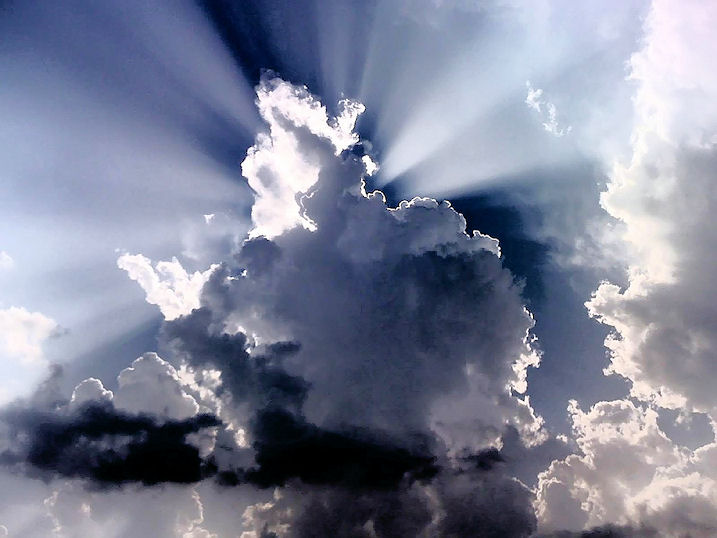
Abb.: Sonnenstrahlen, Kolkata (কলকাতা)
[Bildquelle: Vivek Mukherjee. --
http://www.flickr.com/photos/vivek-mukherjee/2381087214/. -- Zugriff am
2010-07-14. --
Creative
Commons Lizenz (Namensnennung, keine kommerzielle Nutzung, keine
Bearbeitung)]
37. c./d.
koṣṇaṃ kavoṣṇaṃ mandoṣṇaṃ kaduṣṇaṃ triṣu tadvati
38 tigmaṃ tīkṣṇaṃ kharaṃ tadvan mṛgatṛṣṇā marīcikā
कोष्णं कवोष्णं मन्दोष्णं कदुष्णं त्रिषु तद्वति ॥३७
ख॥
तिग्मं तीक्ष्णं खरं तद्वन् मृगतृष्णा मरीचिका ॥३८॥
[Bezeichnungen für lauwarm sind:]
[Bezeichnungen für heiß sind:]
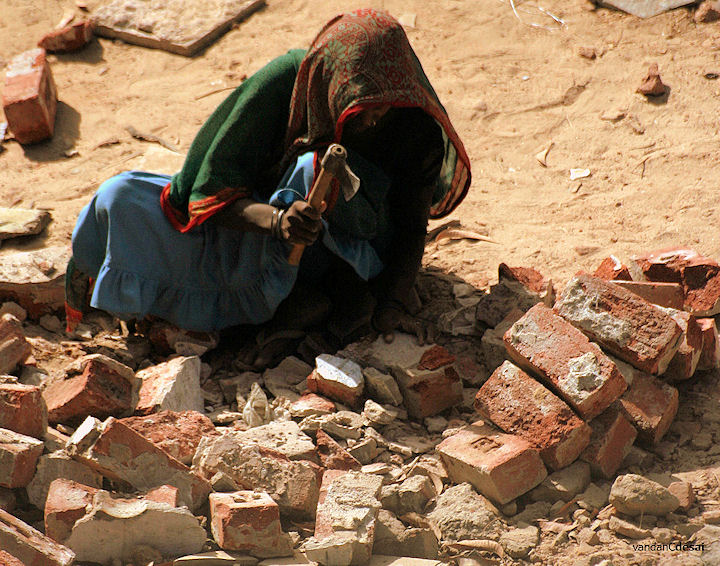
Abb.: Brennend heiß, Gujarat
[Bildquelle: vandan desai. --
http://www.flickr.com/photos/vandan/494348946/. -- Zugriff am 2010-07-14. --
Creative
Commons Lizenz (Namensnennung, keine kommerzielle Nutzung, keine
Bearbeitung)]
[Bezeichnungen für Luftspiegelung1 sind:]
Erläuterungen:
1 Luftspiegelung
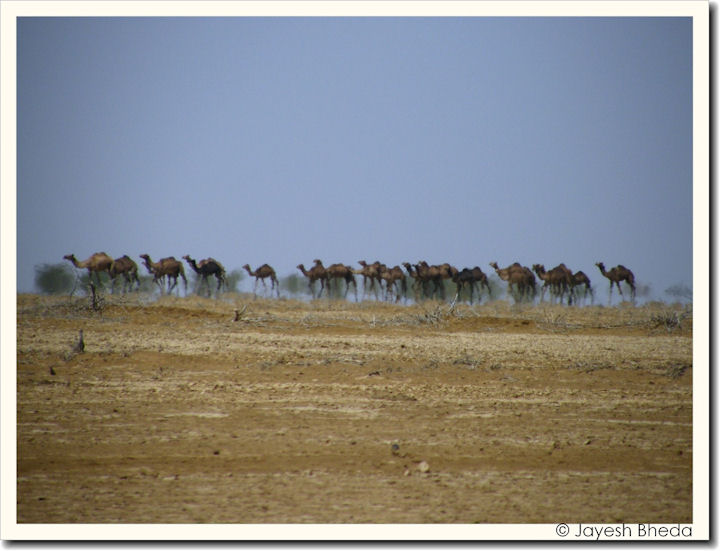
Abb.: Kamelherde mit Luftspiegelung, bei Chari Dhand, Rann of Kutch (رن کچھ),
Gujarat
[Bildquelle: Jayesh Bheda. --
http://www.flickr.com/photos/jvblogger/3364674799/. -- Zugriff am
2010-07-14. --
Creative
Commons Lizenz (Namensnennung, keine kommerzielle Nutzung, share alike)]
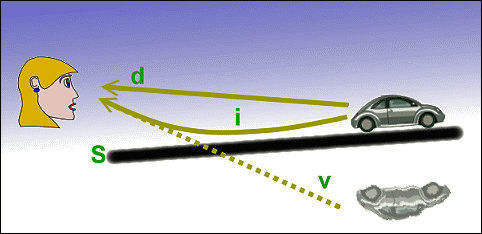
Abb.: Entstehung einer Luftspiegelung
[Bildquelle: Anton / Wikipedia. --
Creative Commons
Lizenz (Namensnennung, share alike)]
"Luftspiegelung, eine Gruppe atmosphärischer Lufterscheinungen, die durch anormale Strahlenbrechung (s. ð Brechung des Lichtes) in den untern Luftschichten entstehen. Bedingung ist, dass diese Schichten verschieden warm und damit verschieden dicht sind. Man unterscheidet Spiegelungen nach unten, nach oben und nach der Seite, je nachdem das Bild über, unter oder seitwärts von dem abgebildeten Gegenstand ist. 1) Spiegelungen nach unten setzen unten warme, lockere, oben kalte, dichte Luft voraus; diese Schichtung entsteht durch Überhitzung des Erdbodens, Eindringen kalter Luft oben oder Erwärmung der untersten Luftschicht von Gewässern her. Diese Art Luftspiegelung ruft hervor: Spiegelbilder nach unten, eine scheinbare Wasserfläche, das Schweben der Gegenden in der Luft (Kimmung oder Seegesicht, holländisch Uppdrächt, englisch Looming, französisch Mirage, in Indien Chiltram, Sikota, bei den Arabern Sehrab). Bei gleicher Dichte der Luft würde der Gegenstand o in a gesehen werden, bei normaler Brechung in b., bei anormaler in b2 oder selten in b3. Das scheinbare Wasser ist das Spiegelbild des Himmels hinter a und wird von ebensolchen wie b2 veranlassenden gekrümmten Lichtstrahlen herausgeschnitten. Zu dieser Gruppe gehören auch die Verzerrungen der Sonnenscheibe beim Untergang sowie die Erscheinung, dass Inseln bisweilen nur in der Mitte auszuruhen, rechts und links aber flügelartig gehoben scheinen.
2) Spiegelungen nach oben entstehen, wenn die Luftdichte nach oben hin rascher als gewöhnlich abnimmt, z. B. bei längerm Frostwetter (s. ð Strahlungswinter), wo die kalte, daher schwere und dichte Luft unten lagert. Häufig ist aber die Dichteabnahme nicht unmittelbar am Boden, sondern erst etwas höher am stärksten; dann werden die Strahlen unten nur schwach konkav zur Erde gekrümmt sein, während die Strahlen, die durch die dichtesten Schichten gehen, sehr stark gekrümmt und total reflektiert werden, sich vor der Reflexion schneiden und daher ein umgekehrtes Bild hervorrufen (man denke sich die Figur ohne Horizont und umgekehrt; a wird in b1, b2 oder b3 gesehen, auch wenn a unter dem Horizont liegt).
3) Spiegelungen nach der Seite entstehen durch ungleiche Dichte innerhalb derselben Luftschicht.
Die Fata Morgana ist eine Luftspiegelung, bei der mehrere obiger Spiegelungen zugleich vorkommen. Sie täuscht in Wüsten Wasserflächen vor (daher Bacher el Alfrid, d.h. Wasser des Satans, Bacher el Gazal), zaubert ganze Städte und Landschaften hervor (häufig in Süditalien), und zwar einfach oder vervielfacht. Sie entsteht bei ungleicher Lagerung und Dichte der Luftschichten (mehrfache und verzerrte Bilder) und bei Störung der ruhigen Lage der Schichten durch leichten Wind (schwankende Bilder). Selten zeigen die Bilder farbige Säume. Vgl. Pernter, Meteorologische Optik (Wien 1902)."
[Quelle: Meyers großes Konversations-Lexikon. -- DVD-ROM-Ausg. Faksimile und Volltext der 6. Aufl. 1905-1909. -- Berlin : Directmedia Publ. --2003. -- 1 DVD-ROM. -- (Digitale Bibliothek ; 100). -- ISBN 3-89853-200-3. -- s.v.]
Zu 1.4. Kālavarga - Abschnitt über die Zeit